May 2025 News
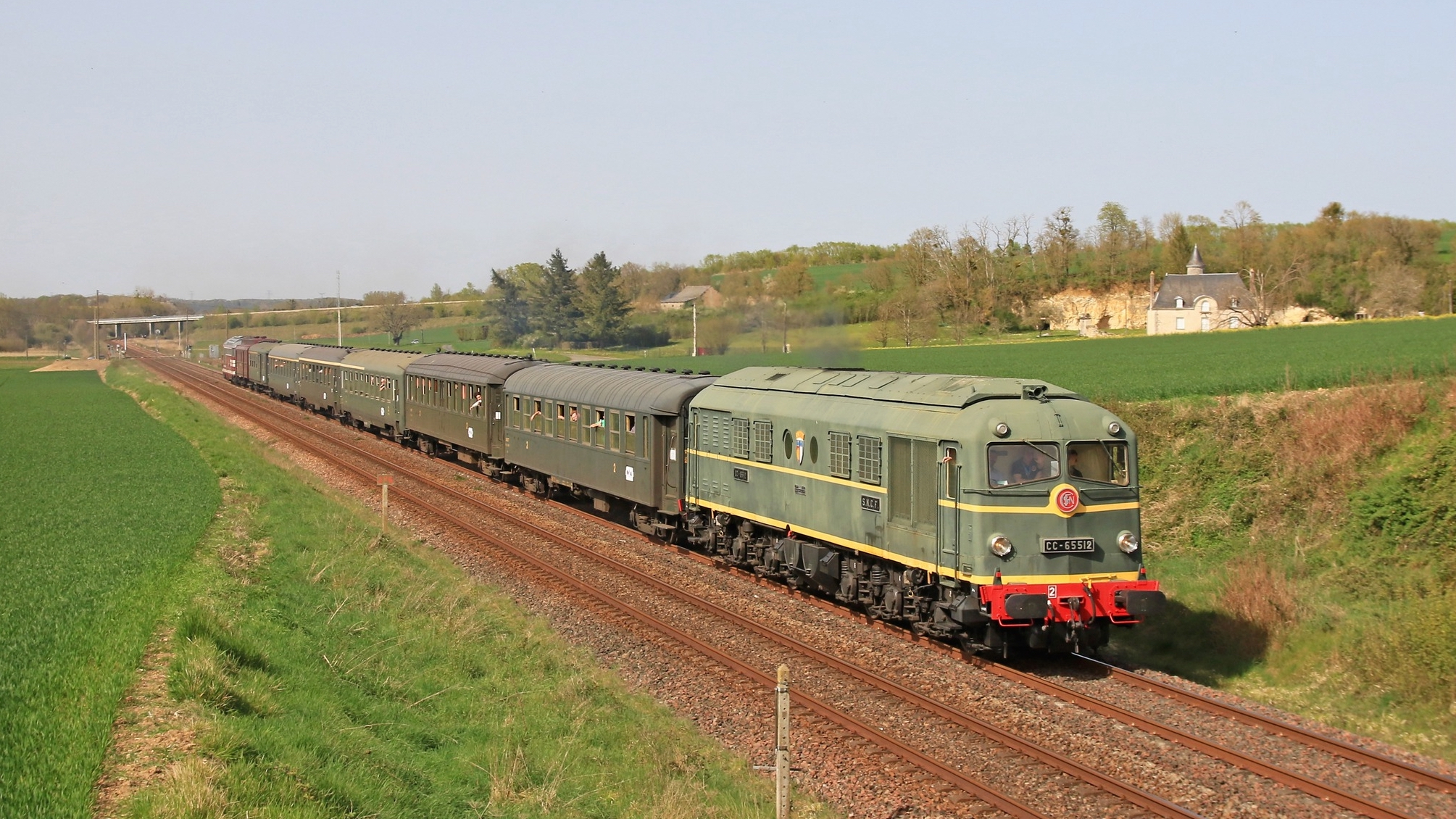
CC 65512 on tour
North of Tours the route avoided running under catenary, and it is seen opposite leaving Château-du-Loir on the outward journey. Photo: Jean-Louis Poggi, and above, near Saint-Christophe-sur-le-Nais on the return journey. Photo: Christophe Masse.
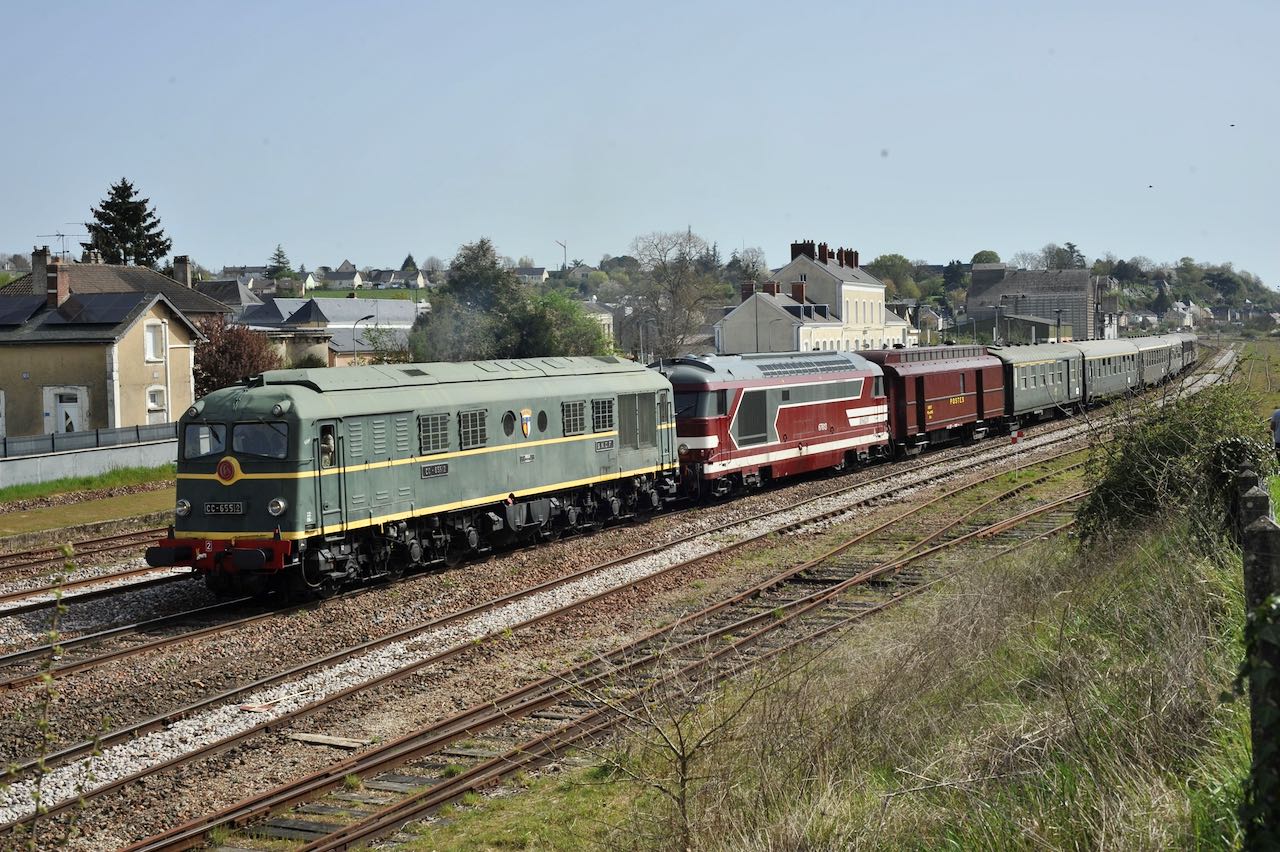
The French Railways Society Summer Rendezvous
MODEL RAILWAY EXHIBITIONSunday June 1st 2025
Ashtead Peace Memorial Hall, Woodfield Lane, Ashtead, Surrey, KT21 2BE (w3w: daily.will.jets) 10am to 4pm Adults £6 Children £2 Family £10
Layouts:
Xertigny-Les-Bains - HO French
Givry Chambertin - N French
SBB Rue Bahnweg - HO French/Swiss
Klein Schmalitz - HO Prussian
Lindsay - HO American
Steninge Heidr - HO Swedish
Circo Minimo - HO Italian
O Gauge Test Track
Givry Chambertin - N French
SBB Rue Bahnweg - HO French/Swiss
Klein Schmalitz - HO Prussian
Lindsay - HO American
Steninge Heidr - HO Swedish
Circo Minimo - HO Italian
O Gauge Test Track
Trade stands:
Scograil of Ipswich
John Rowcroft Pre-Owned Models
Reg Davies Books
Trainsporters Storage System
John Rowcroft Pre-Owned Models
Reg Davies Books
Trainsporters Storage System
Illustrated talks:
Pas de Calais & Picardie Coast
Cerbère
Indian Railways
European Rail Campaign
French Steam 1968-1972
The Society Archive
Society Bring & Buy Stand and Refreshments
www.frenchrailwayssociety.org
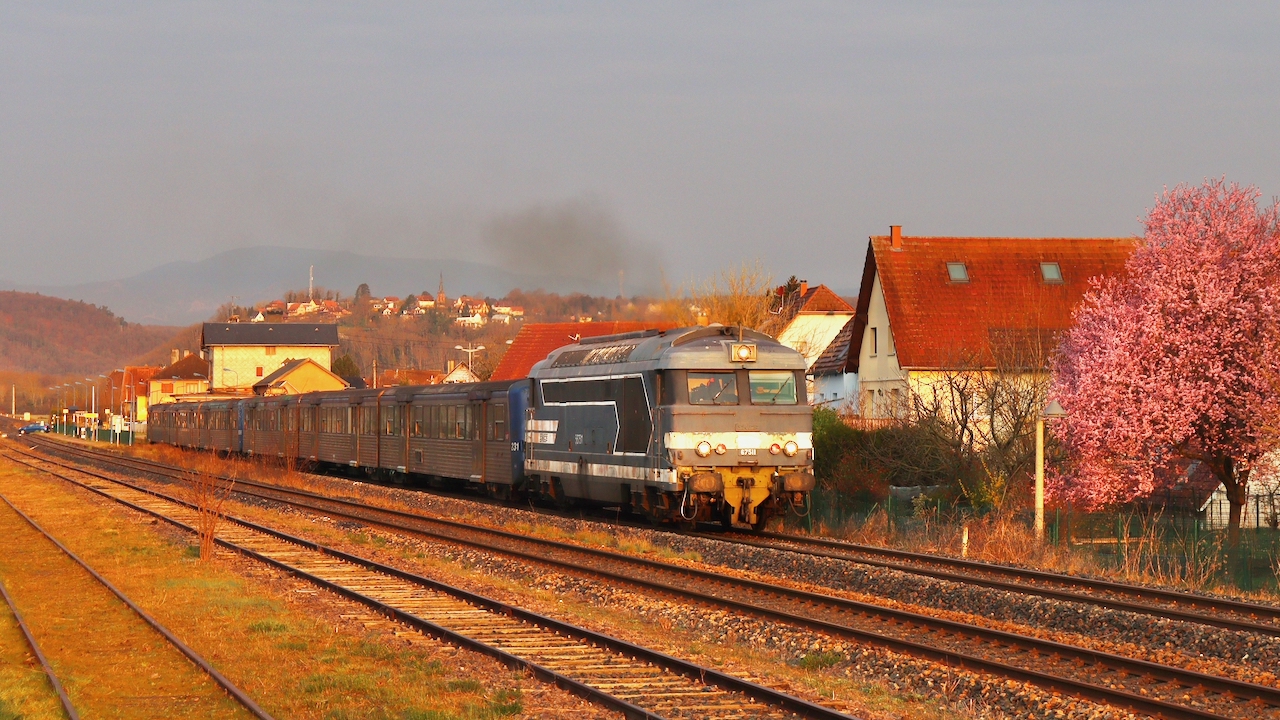
Grand Est TER continues to employ BB 67400s and RRR stock on peak Saint-Dié line workings. Early on 25 March BB 67511, still bearing its 1990s spaghetti stripe livery, catches the rising sun as it heads away from Gresswiller with TER 831809 the 06.11 Saâles – Strasbourg. The locomotive and stock worked from Strasbourg to Saint-Dié the previous evening, then run empty to Saâles for the morning service.
Photo: Gordon Wiseman.
Photo: Gordon Wiseman.
Alstom expands Avelia production
In addition, expansion of drive-systems production and a new train-preparation building at Belfort are going ahead, along with installation of robots and advanced welding systems at the Petit Quevilly, Ornans, Tarbes and Le Creusot component plants. Around 1,000 new jobs will be created.
Alstom has firm orders for 145 Avelia Horizon trains: 115 for SNCF Voyageurs scheduled for delivery at a rate of 15 per year through to the early 2030s; 12 for open-access operator Proxima for its planned services from southwest France to Paris, delivery starting in 2028; and 12 plus option for a further six ordered by Morocco’s state railway ONCF for the Tangier – Marrakech HS line.
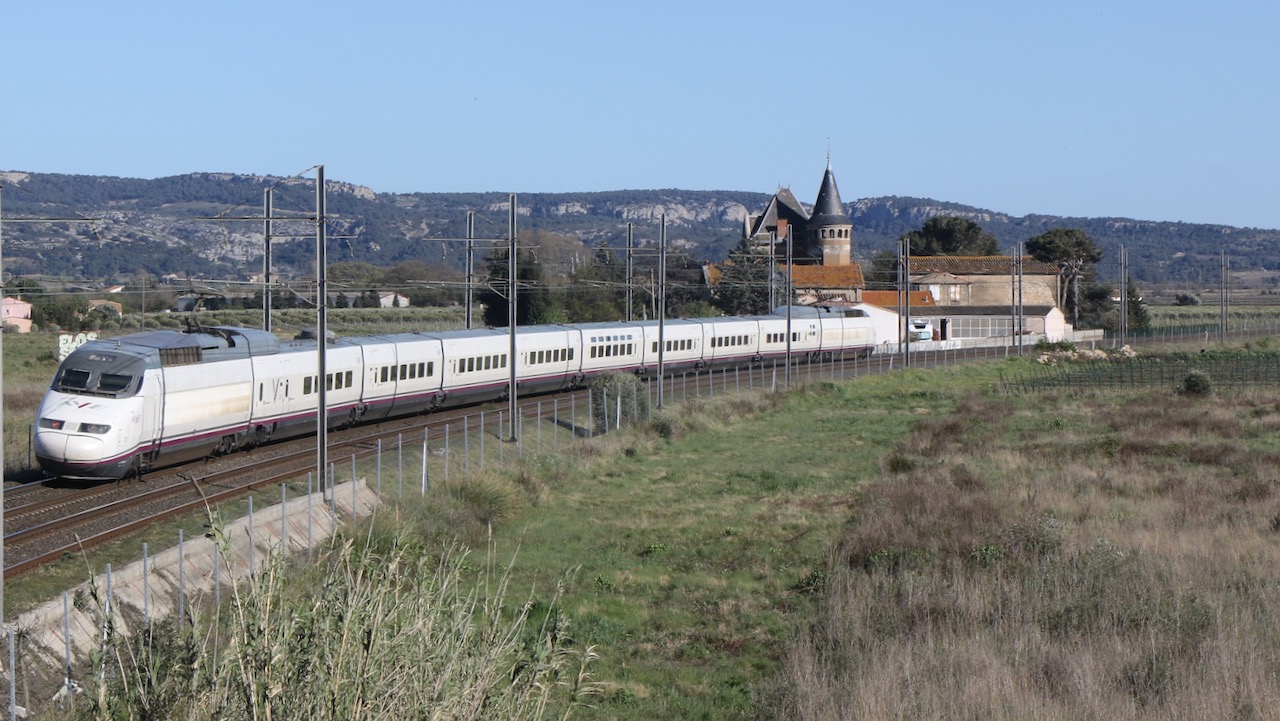
Renfe's only operations in France for the foreseeable future appear to be the cross-border services from Lyon to Barcelona and Marseille – Madrid. On 31 March AVE 21 is seen heading away from Narbonne with Renfe Train 9743 Lyon Part-Dieu – Barcelona. Photo: Georges Turpin.
Renfe ‘reflects’ on French operations
The decision was regretted on both sides of the Pyrénées where Occitan and Catalan officials had worked hard for restoration of a through train. Occitanie president Carole Delga and her Catalan counterpart immediately wrote to the French and Spanish prime ministers to reiterate the importance of the through train to regional development and tourism. “Renfe and SNCF must learn to co-operate…for the benefit of our territories and our citizens," she said.
Catalan newspaper La Vanguardia reported in March that Renfe was considering withdrawal from the French market due to long-standing difficulties in its relations with SNCF and delay in certification Talgo S-106 trains. It is understood that these cannot be cleared to run to Paris until 2029, meaning a five-year delay in launching service from Barcelona to Paris. Renfe’s existing services to Lyon and Marseille are operated by S-100 TGV Atlantique style trainsets, but the S-106s are a typical Talgo design with 13m low-slung coaches of aluminium and composite material construction. They have suffered teething problems in Spain and their certification in France appears to be on hold due to incompatibility with gradients on the Paris – Lyon LGV.
The Spanish government had previously complained of ‘a lack of reciprocity’ in France’s attitude to liberalisation of the rail market, accusing SNCF of ‘dumping’ with uneconomic fares on Ouigo España services as well as obstructing extension of Renfe’s operations in France. According to BFM Business, Ouigo España has taken 20% of the market, but at a loss of €150 million over the past four years. French regulator EPSF had placed ‘a multitude of requirements’ on the Spanish operator which do not apply to SNCF’s operations in Spain, Renfe said.
It remains to be seen whether Renfe’s stance is a challenge to EC regulators or withdrawal in the face of unassailable odds. Three months ago, it had received government approval for creation of Renfe France SAS to take forward the company’s expansion and was named ‘best Spanish company in France’ by the Franco-Spanish chamber of commerce.
Le Train, which plans to introduce high-speed services along France's Atlantic coast, recently announced that the design and planning stage had been completed for its 10 Talgo Avril (S-106) trainsets ordered in January 2023 and construction would begin shortly.
Given the issues faced by Renfe, there must be some apprehension whether Le Train will encounter similar problems. The S-106 consists of a bogie-mounted power car either end of 12 passenger coaches mounted on articulated axles. The complete consist is 200 metres in length and weighs between 287 and 315 tonnes depending on the gauge and power configuration.
Photo: Talgo.
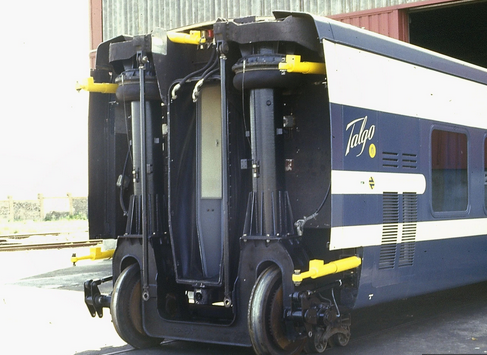
Certification in the spotlight. With new entrants and manufacturers complaining about the lengthy French approvals process, two MEPs were commissioned to look into what goes on. Their report described ‘a cumbersome and costly process’ with a multitude of actors involved and lead-time from placing of an order to delivery into service of more than seven years. ERA’s Technical Specifications for Interoperability comprise 11 principal tests before certification, with a further 54 standards prescribed by the French; the European average is 30. The rapporteurs found that these standards had not evolved over time, while ERA estimated that 17 of them could be revised and possibly dispensed with.
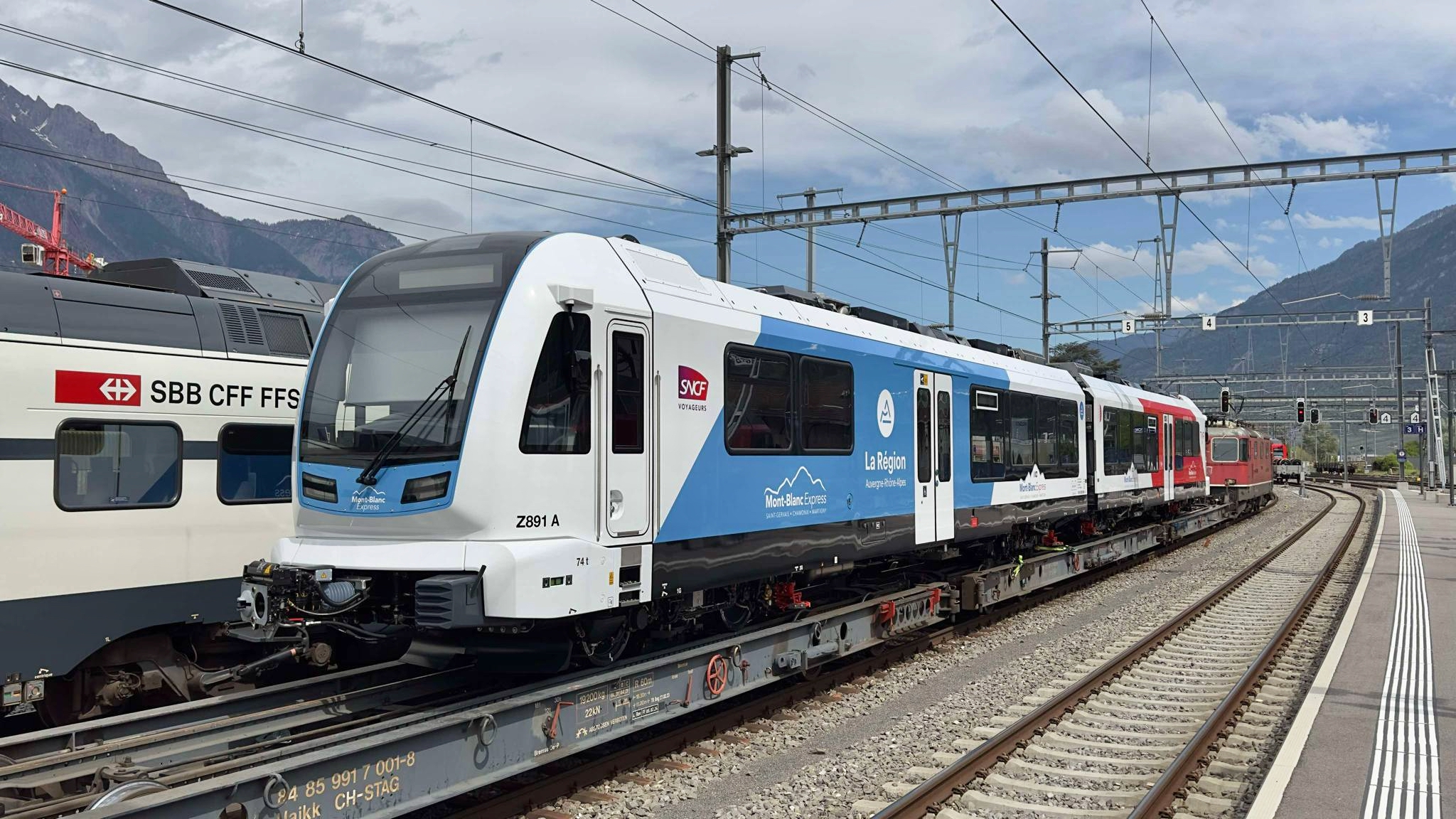
The first of seven Class Z 890 two-car electric units is seen at Martigny on 23 April awaiting delivery from Stadler to the Franco-Swiss Mont-Blanc Express line from Martigny to Vallorcine and Saint-Gervais. Costing €72 million overall, four of the units have been paid for by Auvergne-Rhône-Alpes région and are classified as Z 890s, while the other three have been funded by Canton of Valais and TMR (Transports de Martigny & Régions), classified Beh 4/8. The units each have accommodation for 230 passengers and can operate in pairs, including on the rack sections. They will replace the existing Class 800s that offer poor facilities for people with reduced mobility and no longer comply with Swiss laws on equality of access. Photo: Christophe Masse.
Train des eaux
The train is promoted to those taking cures at the spas, to weekenders and as a means of seeing the striking station building at Vittel. After passenger trains were withdrawn in 2016, Grand Est and local communes made representations to SNCF which led to this limited service over the freight-only line south to Merrey. The usual route from the spa towns to Paris is by bus to Nancy and then TGV, journey time about 3h 20.
Principal traffic on the line to Merrey is another train des eaux, mineral water from local sources moving to Nestlé Waters’ distribution depots at Arles (600km) and Montreuil-Bellay south of Saumur (760km) hauled by dual-mode VFLI/Captrain Stadler Eurodual locos. Under a 2022 agreement between Nestlé, Alstom and green-energy company Engie, it was planned to use Alstom’s hydrogen fuel-cell generator wagon to power a straight electric loco on non-electrified sections, a project later abandoned on cost grounds.
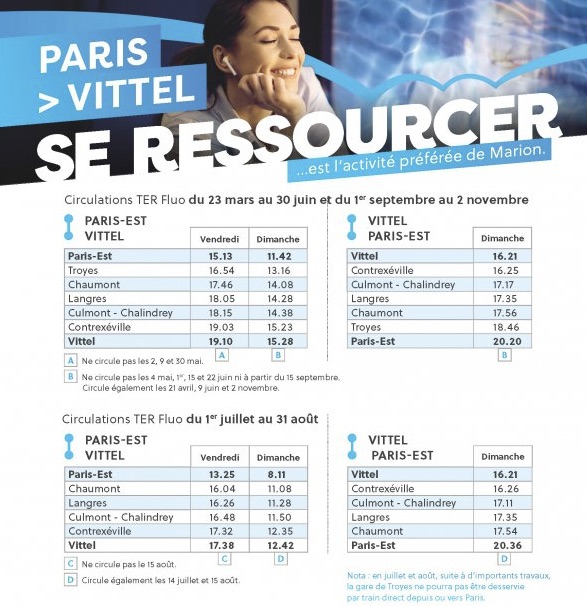
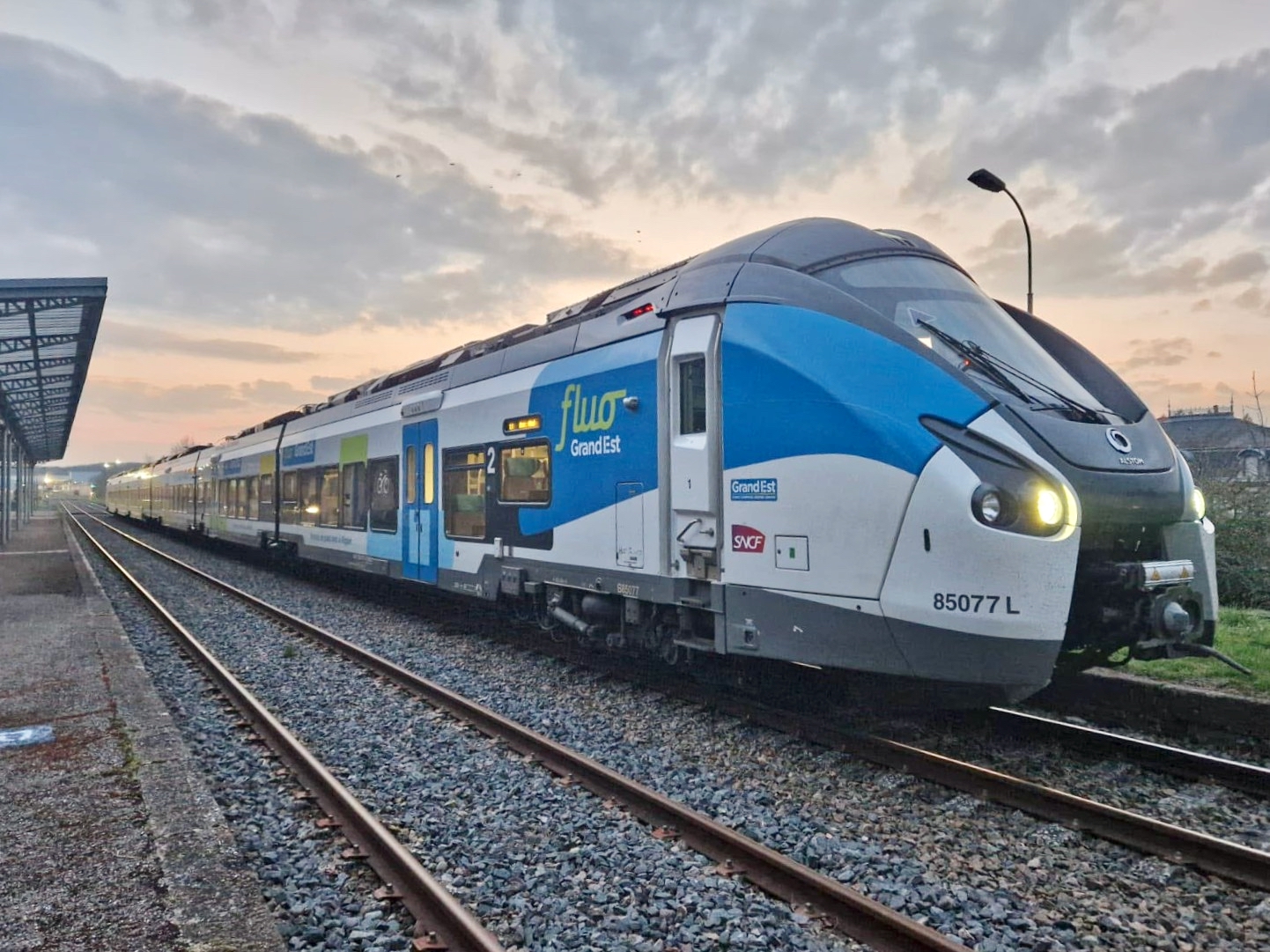
On the first day of the 2025 season, Coradia Liner B 85077/78 has arrived at Vittel with TER 836407 15.13 from Paris Est; just five passengers alighted. Photo: Vosges Matin/TW.
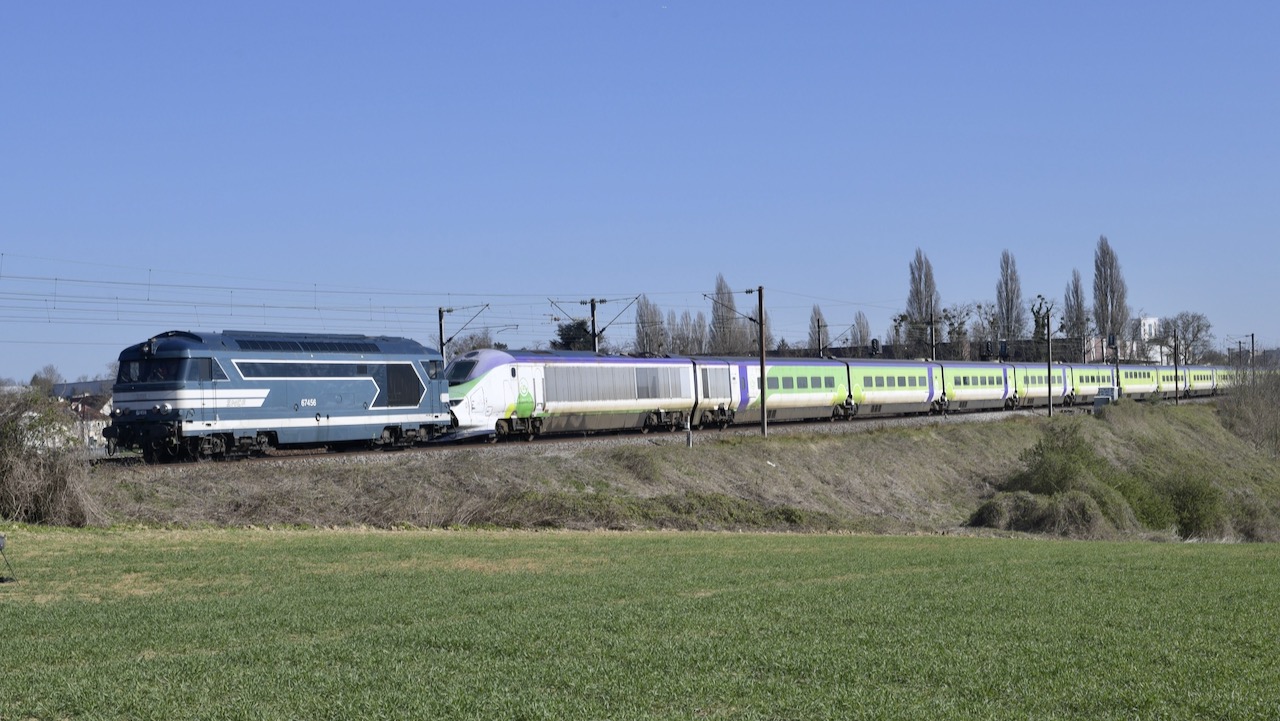
" What happened to Izy?" The low cost service between Paris and Brussels was operated by Thalys from 2017 until 2022, taking the traditional route via Longueau with timings to match. Rolling stock was mainly TGV Réseau sets, but from 2019 until 2021 it was operated by a former Eurostar TMST set with powercars 3213/3224. It is seen above on 1 April at Louvres, north of Paris, being towed by BB 67456 on its final journey from Le Havre to Ambronay, a military base near Ambérieu where many TGVs are stored before disposal. Photo: Jean-Louis Poggi.
Feu vert for Eurostar rivals
With barely 50% of its capacity taken up, there is plenty of room for additional trains on HS1, while in the tunnel itself there are around 600 unused paths daily. LSPH and Eurotunnel have agreed a memorandum of understanding to work together to grow the cross-Channel travel market, focusing on the environmental advantages of rail journeys up to 6h duration.
Temple Mills is the only UK depot capable of accepting Berne-gauge trains and access is essential if new entrants are to avoid the high cost of providing their own dedicated facilities. Studies made for the UK Office of Rail & Road found some spare capacity for more trains to be stabled, serviced and maintained without changes to current operational practices. Further capacity may be delivered through changes to operational and maintenance arrangements, as well as possible alterations to infrastructure. ORR sets out some options for achieving this but Eurostar countered that ‘none would be capable of accommodating the stated ambitions of any single operator’. Significant investment would be needed to support new operators’ ambitions, it said, indicating its willingness to invest in new maintenance capacity, and that ‘other operators should consider investing in the system as well’.
Nevertheless, the new entrants were delighted. All they have to do is raise finance for the trains.
And now FS. Italian state railway FS joined the queue of putative new operators on 7 April, announcing that it would introduce a Paris – London high-speed service by 2029. It plans investment of €1 billion to bring ‘Frecciarossa-style’ trains to the cross-Channel route. It has signed a memorandum of understanding with the Spanish company Evolyn, also a potential new entrant to the cross-Channel market.
SNCF Italian launch delayed
Roll-out of SNCF’s Italian high-speed TGV M services is to start a year later than planned due to problems obtaining sufficient paths. As noted here last month, Italy’s competition authority AGCM is investigating whether state railway FS and infra authority RFI have abused their dominant position in the market to the detriment of SNCF.
Having applied last year to run an initial 13 daily train pairs between Turin – Naples (nine A/R) and Turin – Venice (four A/R), SNCF Voyageurs Italia (SVI) was offered only 30% of the required paths and was denied access to maintenance facilities at Turin. This was followed by a supplementary offer which still left SVI with fewer than half the requested paths, deemed ‘absolutely unacceptable’ for a 2026 launch to make an impact on the market. Despite having started recruitment and training, SVI said it would postpone the launch until 2027. Also included in the bid was the existing Paris – Milan service, to be reduced from three to two trains daily on account of TGV M’s higher capacity than existing TGVs.
SVI plans would see its offer grow to 10 million seats per year with the aim of achieving a 15% market share. SNCF Group hopes its Italian venture will raise foreign operations from 22% to 30% of total business by 2030. At home, allocation of TGVs to foreign open-access services (loss-making in Spain, see above) continues to rankle with passenger groups and trades unions. Observers noted a certain irony that SNCF was receiving ‘a dose of its own medicine’ in Italy following Renfe’s difficulties in extending its French operations.
More Intercité anger
On 15 April the 06.40 Cahors – Paris Austerlitz was named the 'Train of Anger' for the day. Three coaches were reserved to convey to Paris a 200-strong delegation of elected officials, including five members of parliament, business leaders, railway workers and rail users’ associations, to demand swift action to improve reliability of POLT (Paris – Orléans – Limoges – Toulouse) services. Despite significant investment in recent years, users continue to experience delays and cancellations as the 10-year renewal programme enters its final phase. The route is now also proving susceptible to climate change, suffering from extreme heat, wind and rain. The new CAF Oxygène trainsets, originally scheduled for 2023 delivery, are delayed until 2027. At Austerlitz protestors were joined by a similar group from Clermont-Ferrand for a press conference before a small delegation attended a meeting at the Ministry of Transport.
However, the delegations returned home even angrier. The minister was not available to receive them, and a brief meeting with officials ended abruptly with the delegates walking out when the minister’s press release of the previous week was reissued. This detailed the €1.9 billion that will have been spent on POLT and €1 billion on Paris – Clermont-Ferrand infrastructure by 2027, the two largest projects being undertaken by SNCF Réseau this year, and the €800 million being invested in the Oxygène trains. On his visit to Clermont-Ferrand the previous week, the minister also announced establishment of a committee to monitor reliability of the Clermont – Paris line, and offered ‘a gesture to ease passenger frustration’: 10,000 tickets at €19 for the month of June, together with a guarantee of 200% reimbursement when trains are delayed by more than three hours. A similar committee will be established for POLT. The minister said he was seeking additional or replacement locomotives for the 50 and 35 year-old BB 22200s and 26000s from ‘six or seven’ European leasing companies. Locomotive maintenance schedules will be increased, with more preventative maintenance along with the appointment of two specialist engineers.
On climate change, national users’ association Fnaut has commented on increasing use of Stop Circulation, regulations for precautionary stoppage of trains when bad weather is forecast, described by SNCF as adapting to climate change but which Fnaut sees as 'back-covering'. Rural lines and coastal routes are particularly vulnerable, but both TGV Atlantique and POLT were stopped for hours on 6 January during high winds, forcing passengers on to the roads where they would be at greater risk. Fnaut calls for a national vegetation control plan such as that adopted for electrified routes after the severe storms of 1999.
On climate change, national users’ association Fnaut has commented on increasing use of Stop Circulation, regulations for precautionary stoppage of trains when bad weather is forecast, described by SNCF as adapting to climate change but which Fnaut sees as 'back-covering'. Rural lines and coastal routes are particularly vulnerable, but both TGV Atlantique and POLT were stopped for hours on 6 January during high winds, forcing passengers on to the roads where they would be at greater risk. Fnaut calls for a national vegetation control plan such as that adopted for electrified routes after the severe storms of 1999.
News in Brief

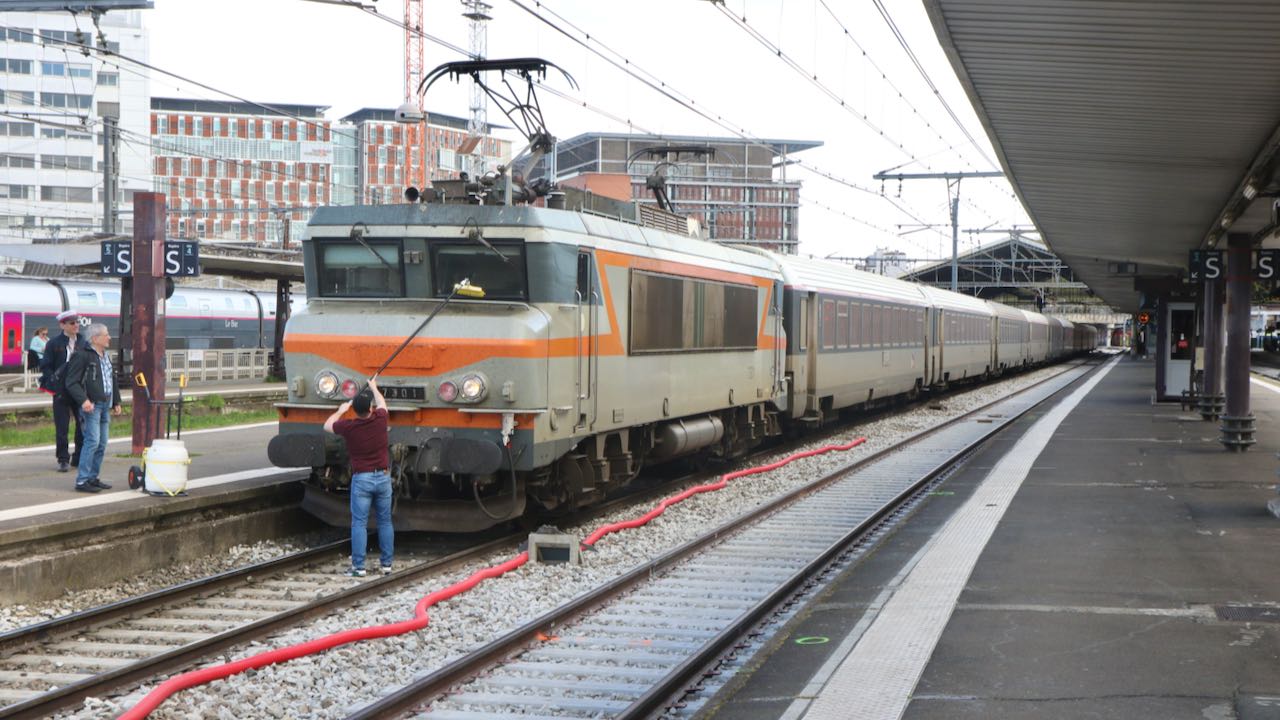
The transport minister will have wondered if there was a voie vert in the Matabiau development plans as BB 7390 arrives at Toulouse with Intercités 4661 Bordeaux Saint-Jean – Marseille Saint-Charles on 4 April. Later that afternoon, a windscreen wash was waiting for BB 7301 on Intercités 4762 Marseille Saint-Charles – Bordeaux Saint-Jean. Photos: Georges Turpin.
Occitanie. Visiting Toulouse on 4 April, transport minister Philippe Tabarot ‘signed the cheque’ for Occitanie région’s spending on transport in the 2023-27 contract-plan period (CPER). Included in the €1.5 billion allocation is €382 million for support and development of rural railways, €164 million for Toulouse area upgrades, €160 million for the Mediterranean freight corridor and €74 million for station modernisation and accessibility work.
Toulouse. Further expansion of centralised control at Toulouse was announced at the end of March. €11.2 million will be spent on an emergency control room where trouble-shooting staff will be based. Computerised control is being extended to all six routes which currently handle over 300 trains a day and which form the core of the city’s proposed SERM network.
Ligne Nouvelle du Sud-Ouest. Taking stock of progress, partners in the renamed GPSO project reported that widening work north of Toulouse and south of Bordeaux was running to schedule. With protesters having succeeded in stopping construction of the A69 Castres – Toulouse motorway, anti-LGV groups have begun legal action in the hope of making a similar coup against LNSO. An application to stop the work on environmental grounds (protection of the European mink) was dismissed by the Bordeaux administrative court on 10 April.
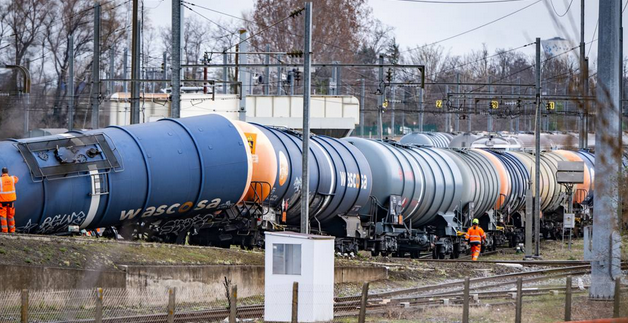
Gravanches. A route-setting error on 23 March caused three tank wagons of a fuel train to be derailed on the hump at Gravanches yard at Clermont-Ferrand. No spillage was reported and no injuries. The wagons were cleared within 36h. Photo: La Montagne/JM.
Bordeaux – Saintes. The first stage is underway of a €70 million upgrade to cut journey time by 15min with overnight work between Beillant and Fontaine d'Ozillac to replace 24km of rail and modernise six level crossings. Bordeaux – Nantes ICs are limited to 50km/h here due to the poor state of the track; on completion of this section in the summer, journey time will be reduced by 6min.
Agen – Périgueux. No through trains have run since November due to defective pointwork at Montsempron-Libos, with passengers bussed to Périgueux on weekdays and required to change at Montsempron at weekends. SNCF Réseau hoped to complete remedial work by 25 April.
Tarbes. The maire of Lourdes has suggested construction of a station adjacent to Tarbes-Lourdes-Pyrénées (TLP) airport which could also serve the proposed regional hospital at nearby Lanne and 3,400 local employees. A multimodal hub would cost €10 million.
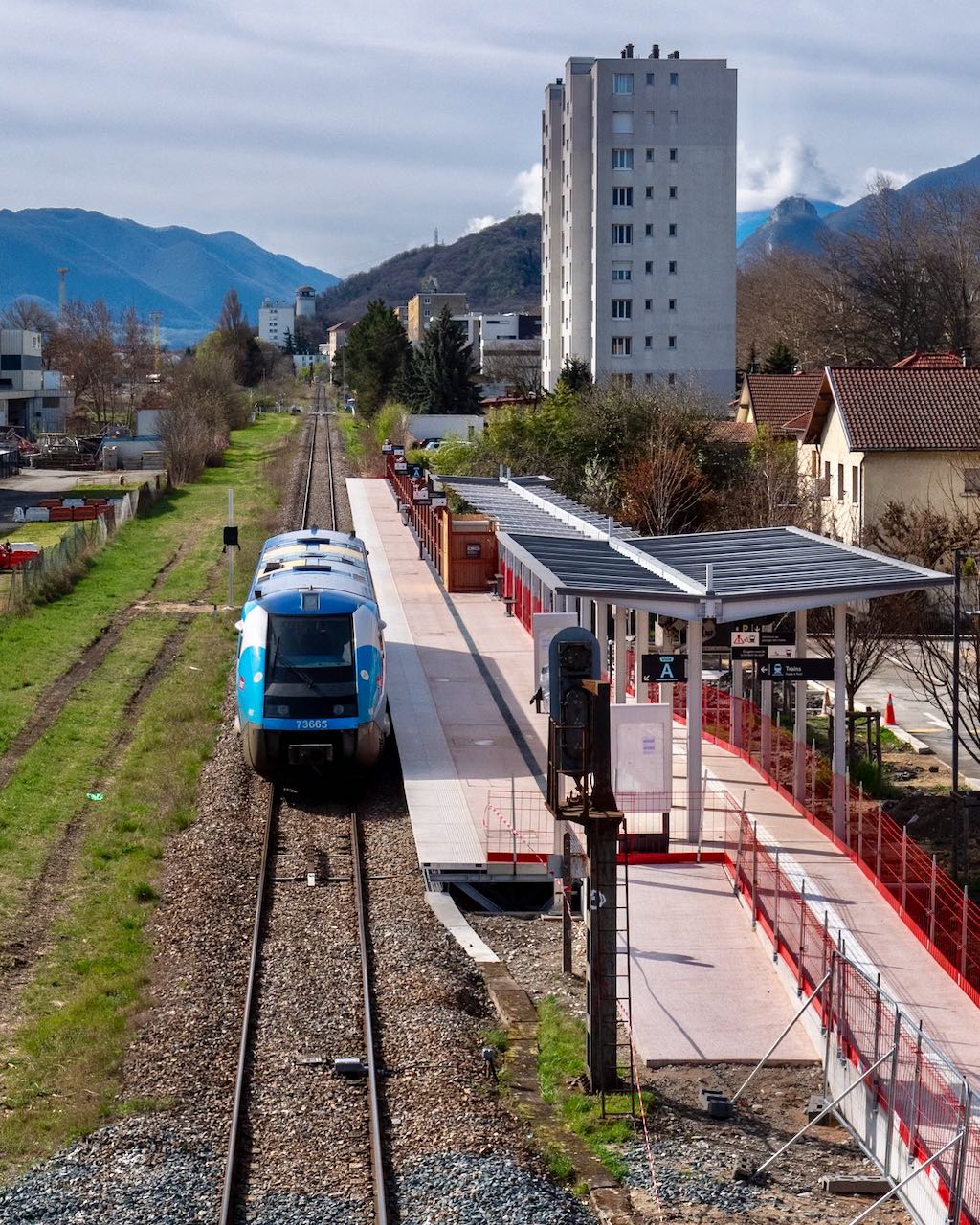
Pont-de-Claix. The relocated halt in Grenoble’s southern suburbs on the line to Gap opened on 30 March, renamed Pont-de-Claix L’Étoile. The new site, 1.2km south, serves the commune’s multimodal hub, connecting with tram route A, buses and carparking. Eight trains run daily to Grenoble, journey time 7min, with a long gap in departures from 09.32 to 14.25. Photo: ADTC Grenoble.

Pays d’Albret. The 27km voie verte linking Feugarolles and Montcrabeau in Gers opens on 21 June. Part of the former Port-Saint-Marie – Condom – Riscle line has been leased from SNCF for 30 years. Extension 8.5km to Condom is planned, subject to SNCF approval. Track remains in situ adjacent to the path in some locations. Photo: Albret Communauté.
Roquefort. The station building at Tournemire-Roquefort, 25km south of Millau on the Aubrac line, is looking for a sympathetic buyer. For a century the dispatch point for the eponymous local cheese, the building is in poor repair but still houses a bar-restaurant. Three A/R call daily.
Dijon – Roissy. Direct TGVs to Roissy-CDG airport, withdrawn in 2020, will run again from January 2027 after Dijon’s maire François Rebsamen received a commitment from outgoing SNCF PDG Jean-Pierre Farandou.
Eus. Visiting Perpignan on 4 April, Fnaut president François Delétraz weighed into the dispute over the damaged bridge near Eus which has seen the Perpignan – Villefranche Vernet-les-Bains line truncated since last June. “How can private interests take precedence over the common interest?” he asked. “700 people [daily] can no longer take the train because the owners of a pig farm and a guest house do not want the bridge taken down. It's nonsense." Eus commune continues to prevaricate over demolition on cost grounds.
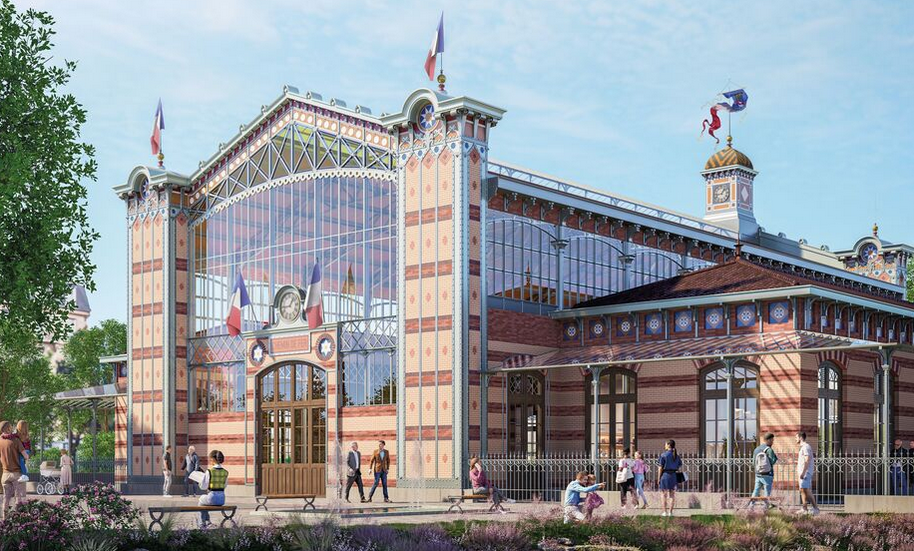
Asnières-sur-Seine. The Gare des Carbonnets, built for the Paris World’s Fair of 1878 and rebuilt at Asnières in 1897, is to be restored as co-working space after lying unused for 40 years. Also known as Gare Lisch after its architect Juste Lisch, the building was bought by the commune in 2021. Artist impression: DRAC.
Île-de-France. ÎdeF Mobilités has approved orders for a further 96 RER NG trains at a cost of €2.1 billion to continue renewal of the RER Line D fleet. Following recent delays, Alstom is charged with providing regular progress updates and strict adherence to the delivery timetable.
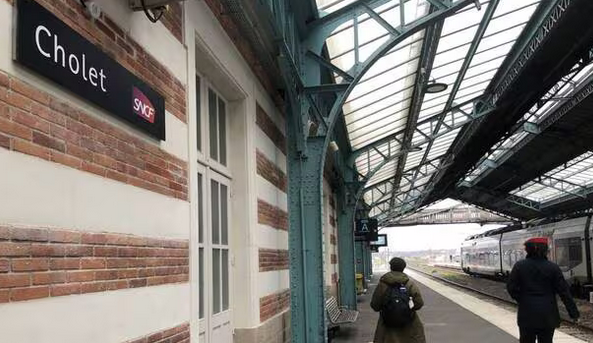
Cholet. Restoration of the station building is complete after several years’ work. The final stage included replacement of degraded brick facings on the platform-side façade using material recovered from one of the town’s oldest buildings, the 15thC Maison Adam, where a chimney was dismantled last year. Photo: Ouest France/FR.
Bâle-Mulhouse airport. The impact study of the environmental effects of the proposed loop to serve the EuroAirport has been called into question by the Strasbourg administrative court, where protesters had sought annulment of the project’s Declaration of Public Utility. Rejecting the application, the court nevertheless criticised the impact study, calling it ‘insufficient’ and ‘wrong’ in several respects. The promoters have 12 months to produce a new version. Estimated cost of the 6km loop has risen to €460 million.
Tours. An electrical fault led to a fire on 29 March which severely damaged signalling installations. No trains ran until 28 April whilst engineers replaced burnt cables and fibre links for power and telecommunications, and the entire signalling system which was in any case due for renewal.
Luchon reopening. The Montréjeau – Luchon line, closed since 2014, will reopen on 22 June. It is no longer electrified and will initially be operated by diesel units, later to be replaced by hydrogen units. An official inauguration of the renovated station building took place on 25 April. Six return trips a day are planned although no timetable details have been released yet.
Toulouse – Auch under threat. A stand-off between SNCF Réseau and Occitanie région could see Toulouse to Auch close at the end of next year, leaving the Gers département without any railways. The line was one of the first to benefit from the ‘Midi-Pyrénées Rail Plan’, with track renewal in 2008-09. Since then there has been ongoing work on bridges and crossings, but a further €20 million is required to retain the line beyond next year.
Opposite. On 16 September 2024, Régiolis B 83529/30 M has arrived at L'Isle-Jourdain with TER 870411 from Toulouse. The signalling seems to have been replaced by a hand-operated stop indicator. Photo: Georges Turpin.
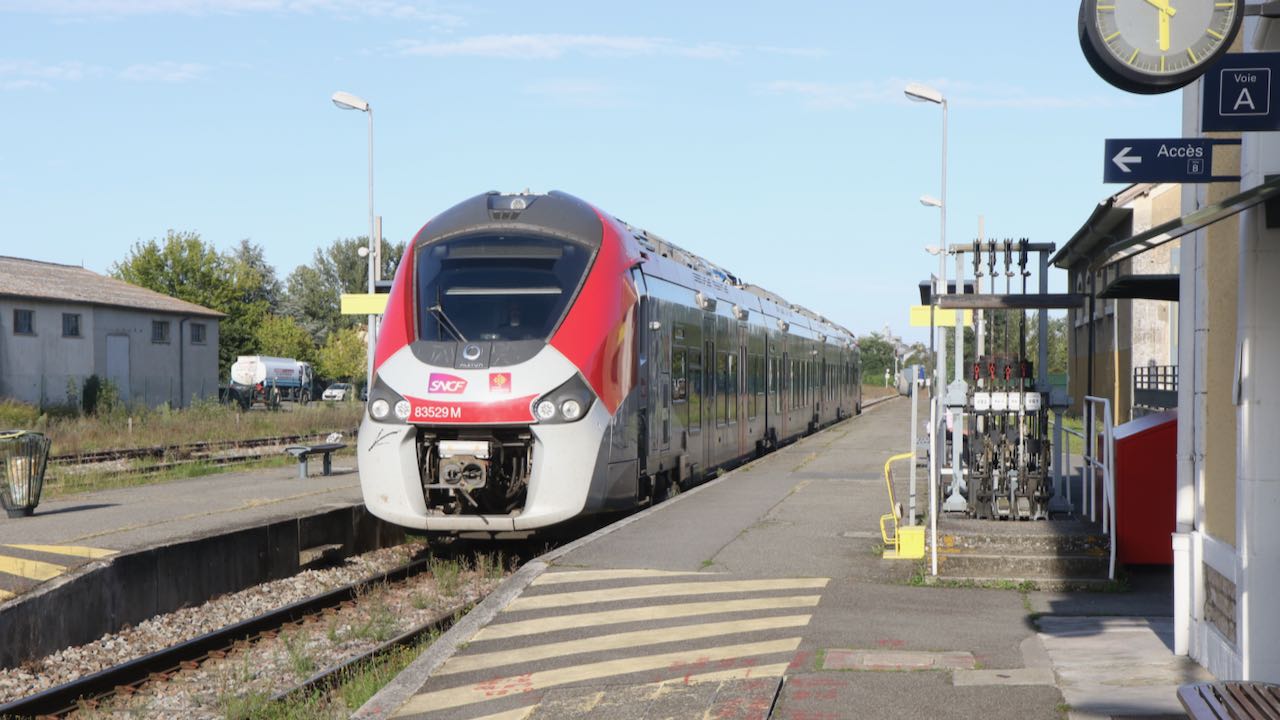
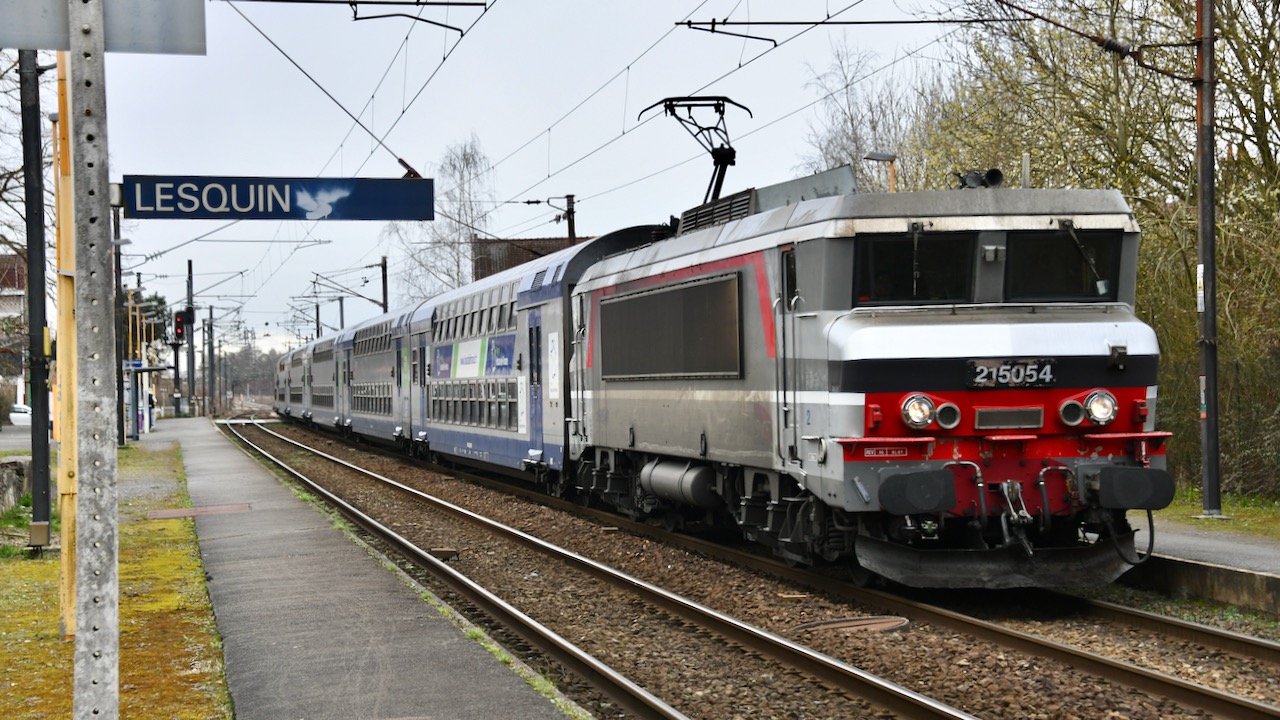
At the end of March BB 15000s finally finished working from Saint-Lazare, there being ample BB 27300s for the dwindling number of workings on Transilien Lines L/J. BB 15000s retain some workings from Gare du Nord, although during March BB 15054 was undertaking compatibility testing from Lille with rakes of five and six coach V2N stock which is to replace the VR2N stock currently used. On 13 March BB 15054 is seen at Lesquin with a test run from Lille to Hirson. Photo: Didier Delattre.
‘RER Level 1’ for Lyon
At the same time, partners in the SERM project gave the go-ahead for studies by Société des Grands Projets for the Level 2 stage which will give most lines a 15min interval service. This will require substantial investment over the coming decade: €1.3 billion for infrastructure, €250 million for expanded maintenance facilities, and 150 new trains costing €1.6 billion. The first order was placed on 31 March; another 10 Regio 2N MUs will be added to the batch of 19 currently being delivered by Alstom. Entering service in the second half of 2027, they will be based in Lyon apart from two sets destined for the Rhône Rive Droite extension to Le Teil.
AURA’s transport vice-president Frédéric Aguiléra described the Level 1 improvements as a major step in development of Lyon’s SERM network based on frequent even-interval services throughout the day. The earlier start will provide connections from inner-suburban stations into the first TGV departure for Paris (Perrache 05.50, Part-Dieu 05.58) as well as offering more choice for local commuters. Extra capacity will come from optimisation of rolling stock, shorter turnround times, improved maintenance and better timetabling. Nevertheless, it is recognised that the fleet will be hard-pressed and no further expansion will be possible until additional stock comes on stream.
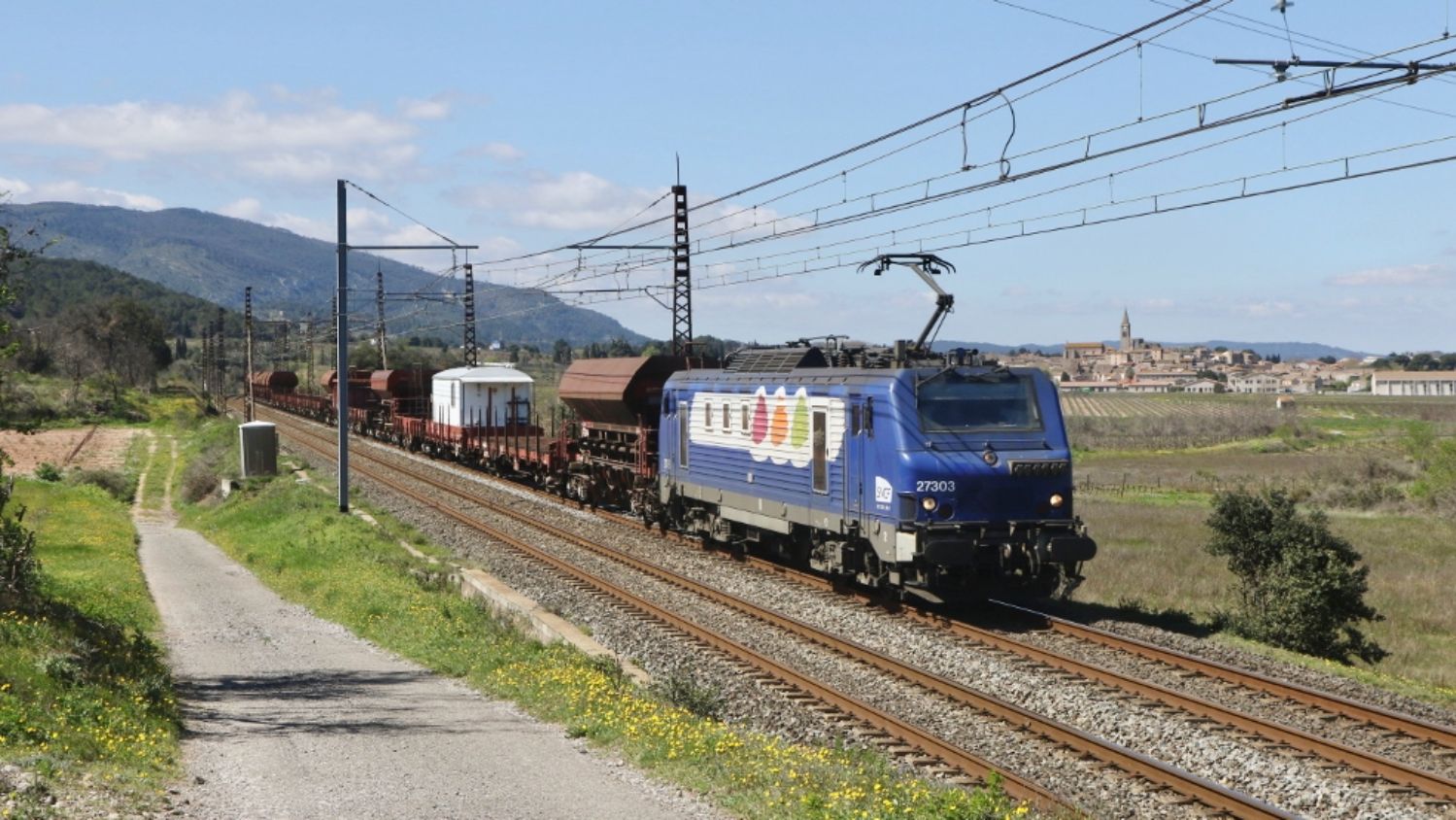
With a declining workload on RER lines L and J, a further six BB 27300s were withdrawn during February. The Infra sector now operates a fleet of 12, all still in their Île-de-France Mobilitiés teardrop livery. On the morning of 31 March, BB 27303 is seen between Capendu and Douzens, southeast of Carcassonne working Train 66009 Hourcade – Portes.
Occitanie freight
Taken on 31 March, the selection above and below illustrates the variety of freight to be seen south of Toulouse, dominated by Alstom Primas in a variety of liveries. All seen near Capendu or south of Narbonne unless stated. Photos: Georges Turpin.
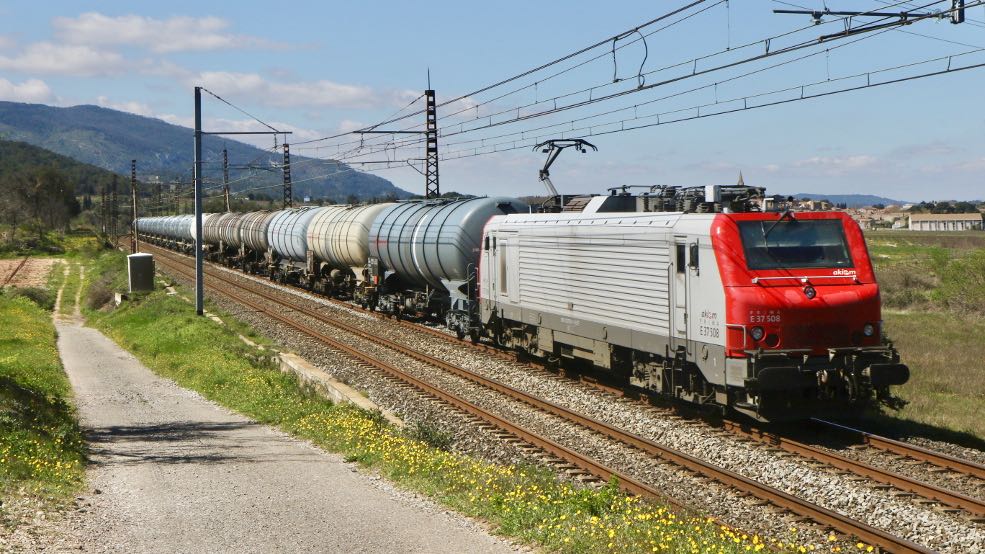
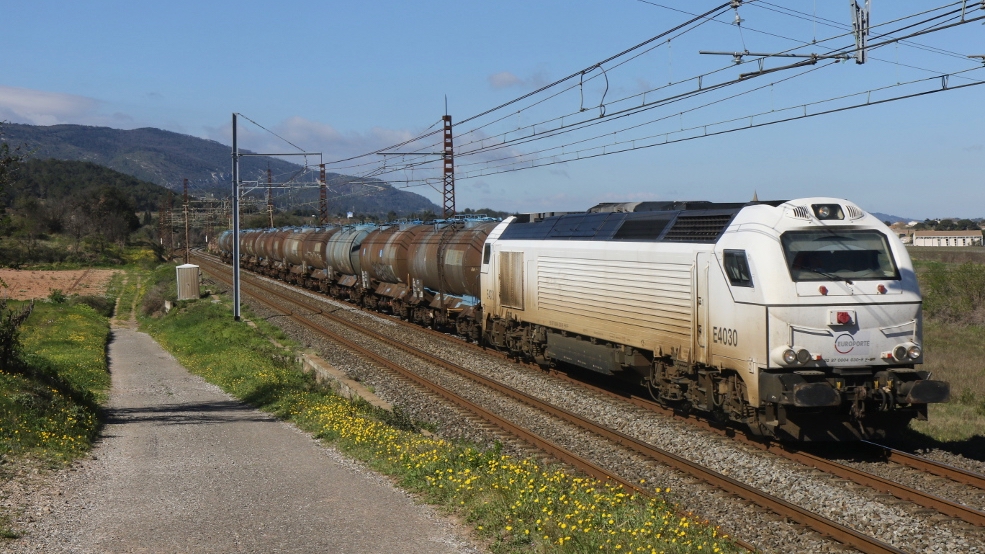
Above left. Near Capendu Europorte E 37508 on Train 489007 Toulouse – Fos – Cossoul empty petrol tanks, and above right Europorte Vossloh E4030 Train 418021 Prahecq – Saint-Jory – Colombiers empty wine tanks. Lower left. A quick detour further south to Port-la-Nouvelle to see if there was a Stadler Eurodual on 43141 Gevrey-Triage – Perpignan Faisceau International found Captrain E 37506. Lower right. Just south of Narbonne Regiorail BB 27156 still in Lineas livery. Train 50944 Perpignan – Valenton. Bottom Left. Hexafret BB 27024 Train 52968 Perpignan Faisceau International – Woippy. Bottom right. DB Cargo E 186 304. Train 50934 Perpignan – Dourges.
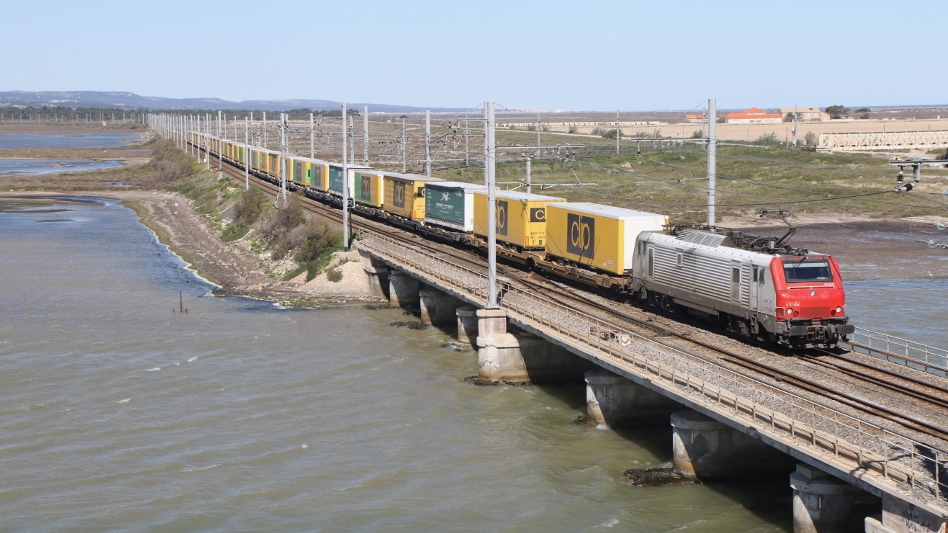

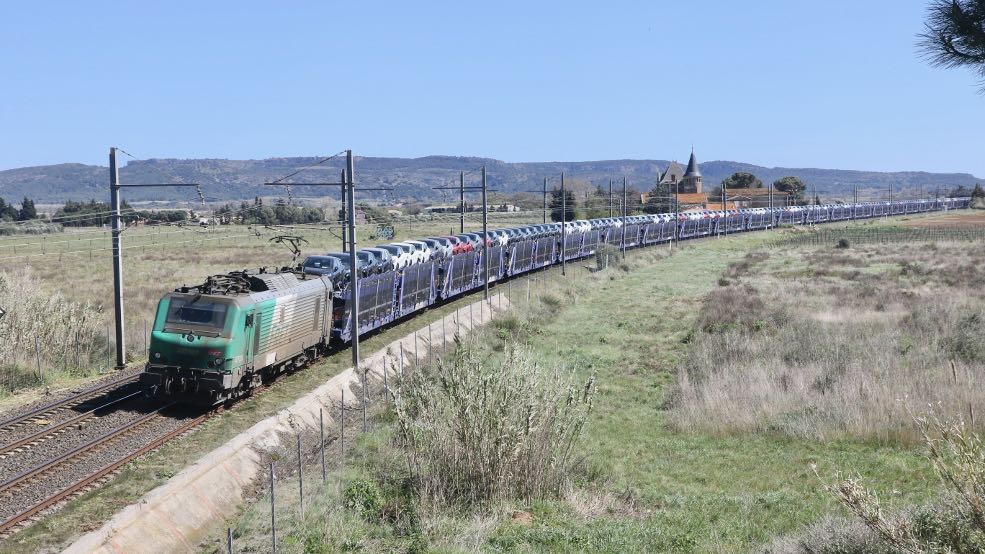
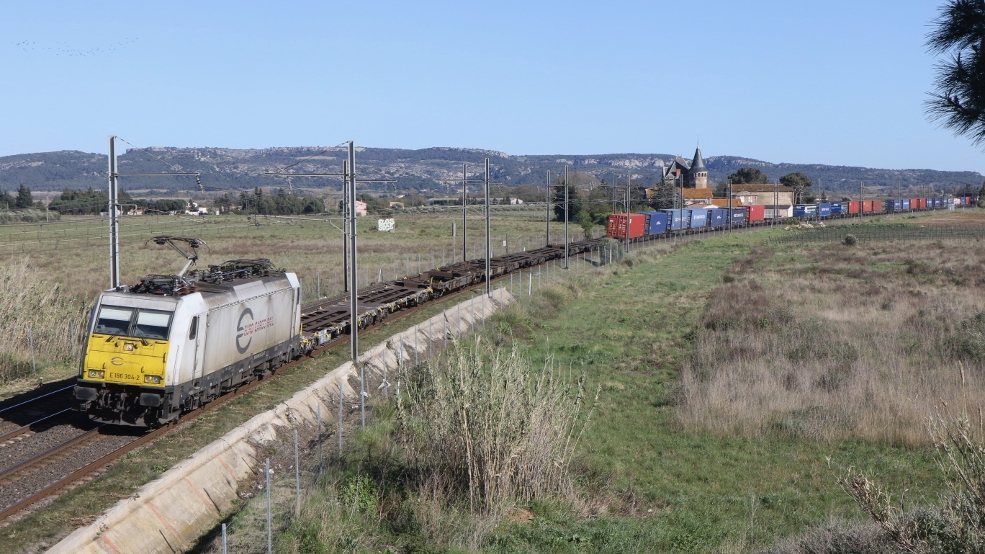
Ulysse charts a future for freight
Conventional freight: €717 million for freight track capacity improvements and €118 million for marshalling yard projects to assure retention of 8.5 billion tonne-km of traffic, with €71 million investment going to Woippy, Sibelin, Miramas and Le Bourget yards.
Freight lines. €700 million for rejuvenating 140 lines extending to some 2,000km, of which €60 million will be spent in 2025 and an average of €100 million per year thereafter, allowing rail to retain 5.5 billon tonne-km.
Terminals and private sidings: €200 million for modernisation of these often-neglected facilities, and development of new sites according to local needs.
Digitalisation: €199 million for systems to harmonise data transfer between SNCF Réseau and freight operators, and apportion track capacity.
Capacity and clearance: €982 million for network modernisation and lengthening loops and layby tracks to accommodate 850m-long trains; €530 million to complete the work of enhancing loading-gauge clearance for semi-trailers.
Intermodal: As announced last year, €1.1 billion to increase capacity for intermodal transport and develop of new terminals (€430 million).
Ulysse is described as the result of a ‘unique partnership’ between government, SNCF, freight operators and customers. It will put forward schemes which offer the greatest impact, both short-term ‘quick wins’ and longer-term ‘ambitious’ projects to be carried out by 2032. Investment would come roughly 50% each from the State and private sector. For the current year, €213 million has been earmarked.
Freight lines upgraded
Current projects in Grand Est provide good examples of the problems Ulysse aims to address by eliminating the uncertainty facing shippers wanting to use lines in poor condition. Grain haulage on two freight-only lines will be assured for 10 years on completion of upgrading works. The 70km from Oiry (Épernay) to Esternay reopens in July after six months’ work by Socorail and TSO/Offroy to replace sleepers, rail and ballast at a cost of €30 million, while the Coolus (Châlons-en-Champagne) to Luyères line (89km) is benefiting from an ongoing renovation programme costing €50 million.
Some remedial work on the two lines was carried out in 2016, but by 2022 it was clear that major expenditure would be required if traffic was to continue. With SNCF unable to finance the work, Grand Est région and local communes sought a State contribution towards the cost, and an agreement was reached under which the State would provide 48%, départements and communes 25% and the région 27%.
The Esternay line serves cereal silos at Coligny, Fère Champenoise and Esternay, plus a sugar-beet processing plant at Connantre. On the Luyères line there are five branches variously serving silos at Coolus, Nuisement, Charmont and Luyères, a sugar plant at Arcis-sur-Aube, and a military branch and silo at Mailly-le-Camp. Another branch serves the freight airport at Vatry, and at Sommesous there is an aggregates terminal. Between them, the lines carry around 575 trains of grain, cereals, sugar beet and other traffic a year.
Both lines laboured under a 30km/h speed limit and are single track with ‘one train’ operation apart from 6.5km of double track between Châlons and Nuisement. This creates logistical problems: when a locomotive fails, shippers must often resort to road transport to fulfil their commitments. The current work will raise line speed to 40km/h but no signalling solution has been provided to allow running of more than one train at a time, either by using passing loops or by locking trains into sidings whilst they load.
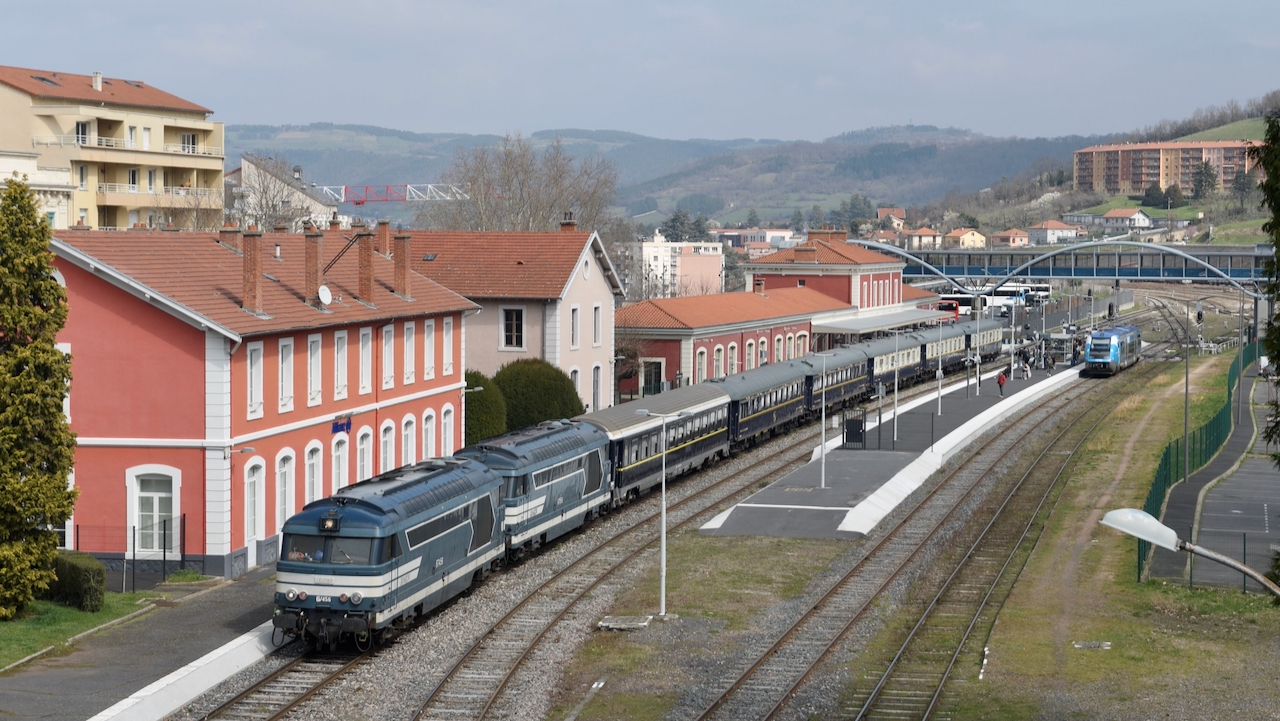
On 25 March the Hermès Orient Express undertook a tour of the Massif Central for Hermès executives and invited guests. Starting from Paris Austerlitz, the train travelled to Montluçon, Clermont-Ferrand, Saint-Étienne and Le Puy-en-Velay before returning to Paris via Montluçon and Limoges. Hauled by CMR's BB 67456/67556, the train consisted of five CIWL vehicles formerly part of the SNCF Pullman Orient Express and a Corail coch painted in CIWL livery. The train is seen above at Le Puy, and below on the single-track section between Le Puy and Saint-Georges-d'Aurac. Photos. Jean-Louis Poggi.
Hermès International SA has now taken a majority stake in the ownership of the former Pullman Orient Express from SNCF. This has only operated infrequently in recent years, since three of the coaches were on display with 230 G 353 in an Orient Express exhibition at the Institut du Monde Arabe in Paris in 2014. Alongside the Belmond VSOE, these are the only luxury trains currently operating in France. Next year they will be joined by the Accor Orient Express (OE), part of a new brand of luxury hotels, trains and sailing ships being developed by the Accor hotel group in partnership with LVMH (Moët Hennessy Louis Vuitton). The OE comprises coaches from the former Nostalgie Istanbul Orient Express that were discovered stored in a yard on the Polish/Belarus border in 2017. The 17 coaches, comprising of 12 sleeping cars and 5 day/catering cars, are being restored by ACC at Clermont-Ferrand (see October News). While the VSOE has been restored to re-create 1920s standards of luxury, the OE is being developed with contemporary standards of luxury, the suites and cabins containing double beds and en-suite facilities.
Last month OE launched the La Dolce Vita Orient Express in Italy with a nine-coach 1960s-era train offering circular tours from Rome. In France, a further luxury train is being restored at AFF Somain sponsored by the Puy du Fou theme park for Le Grand Tour; it will have 21 two-berth cabins. Six-day tours of France are being marketed, the train following a 4,000km itinerary visiting Reims, Beaune, Avignon, La Rochelle, Chenonceau and Paris.
Last month OE launched the La Dolce Vita Orient Express in Italy with a nine-coach 1960s-era train offering circular tours from Rome. In France, a further luxury train is being restored at AFF Somain sponsored by the Puy du Fou theme park for Le Grand Tour; it will have 21 two-berth cabins. Six-day tours of France are being marketed, the train following a 4,000km itinerary visiting Reims, Beaune, Avignon, La Rochelle, Chenonceau and Paris.
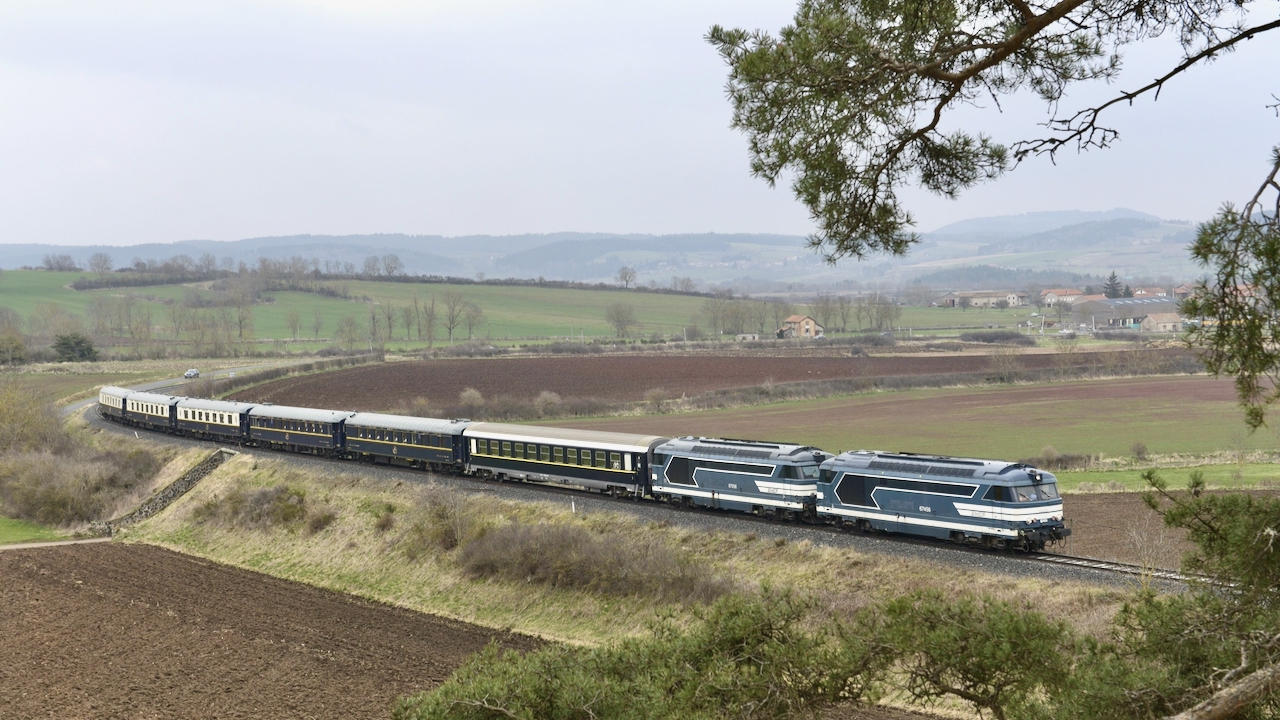
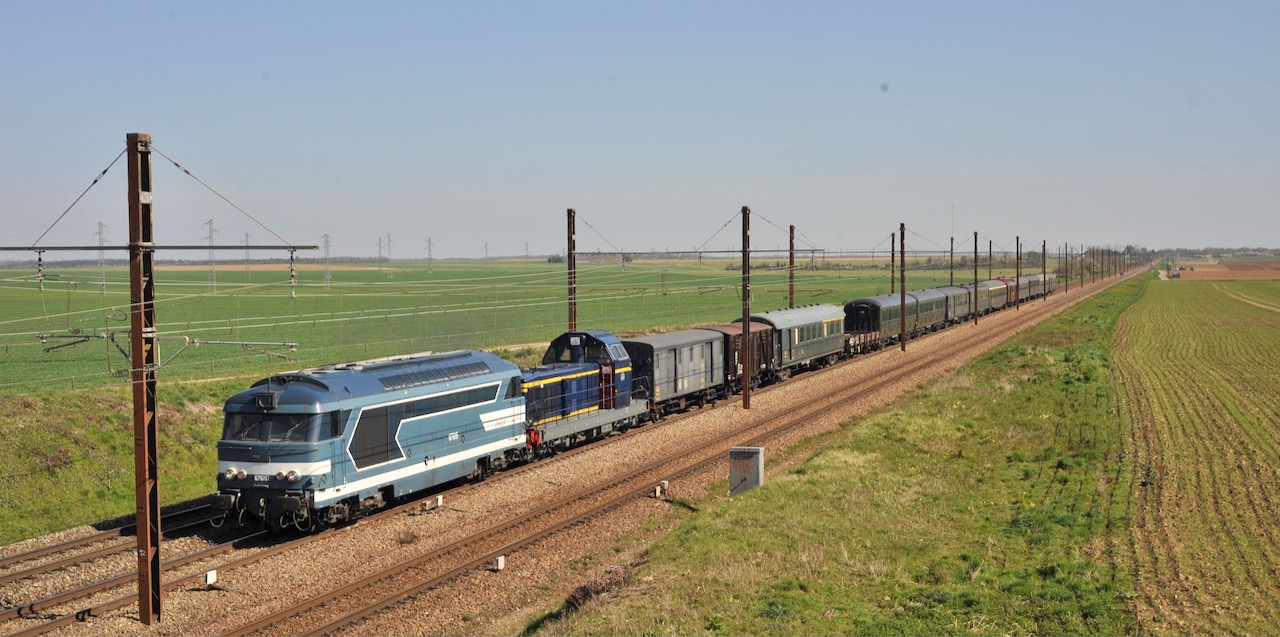
Historic rolling stock from CFTLP at Limoges and AAATV Centre-Val de Loire at Les Aubrais was used in the filming of 'Luchaire' at Paris Austerlitz on the 1 April. The following day the stock returned and is seen above at Monnerville, mid-way between Paris and Orléans, headed by BB 67615 and BB 69421. Photo: Jean-Louis Poggi.
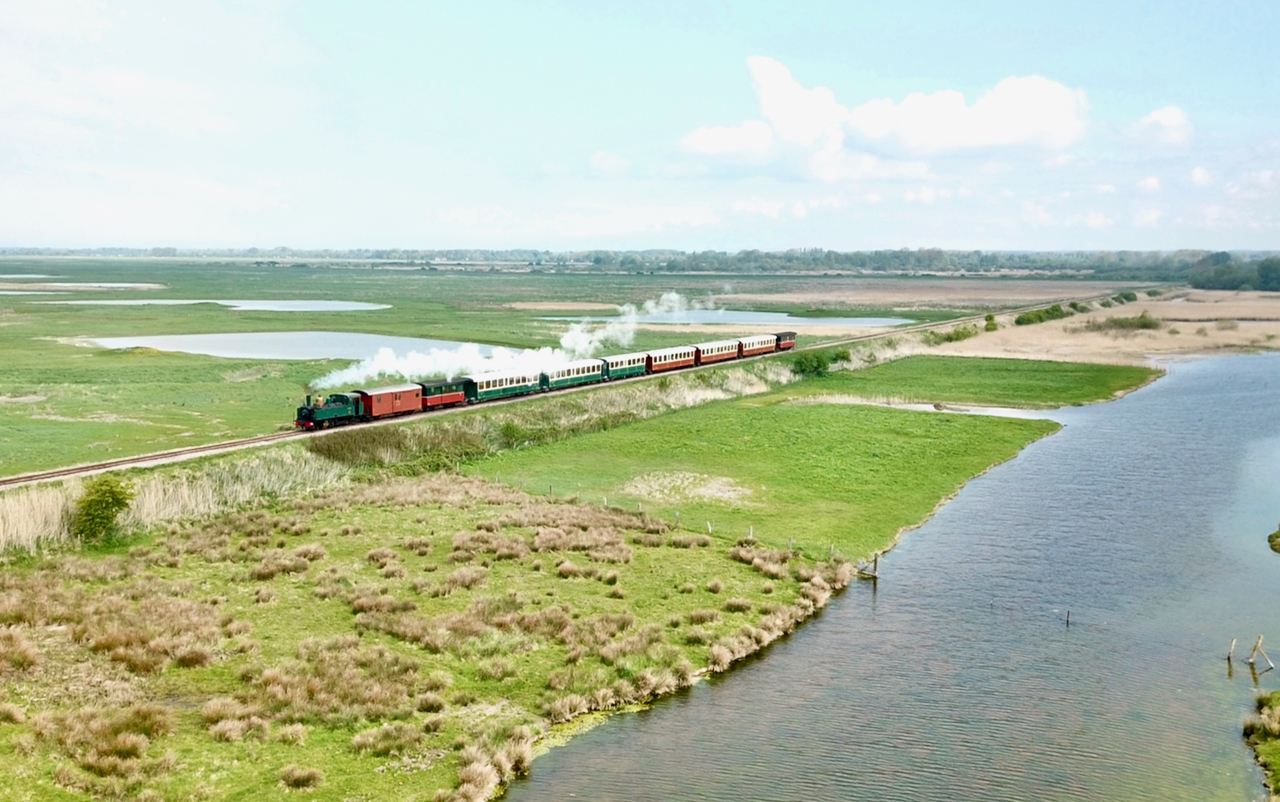
On Easter Monday CFBS Haine St Pierre No 15 heads along the causeway between Noyelles and Saint-Valery with the 11.00 from Le Crotoy. The next CFBS Fête de la Vapeur will take place over the weekend of 25/26 April 2026 with an ‘Off’ event on Friday 24 April. It is hoped to have five visiting locomotive from Germany, Luxembourg and France although these have not yet been confirmed. Visiting locomotives and crews will undertake route clearance and familiarisation between 18 and 22 April and may appear on service trains. As in previous years, the centre of the event will be at Noyelles. It is planned that the station at Cayeux will have a military theme, Saint-Valery Ville a ‘station of yesteryear’ and a Steampunk theme at Le Crotoy.
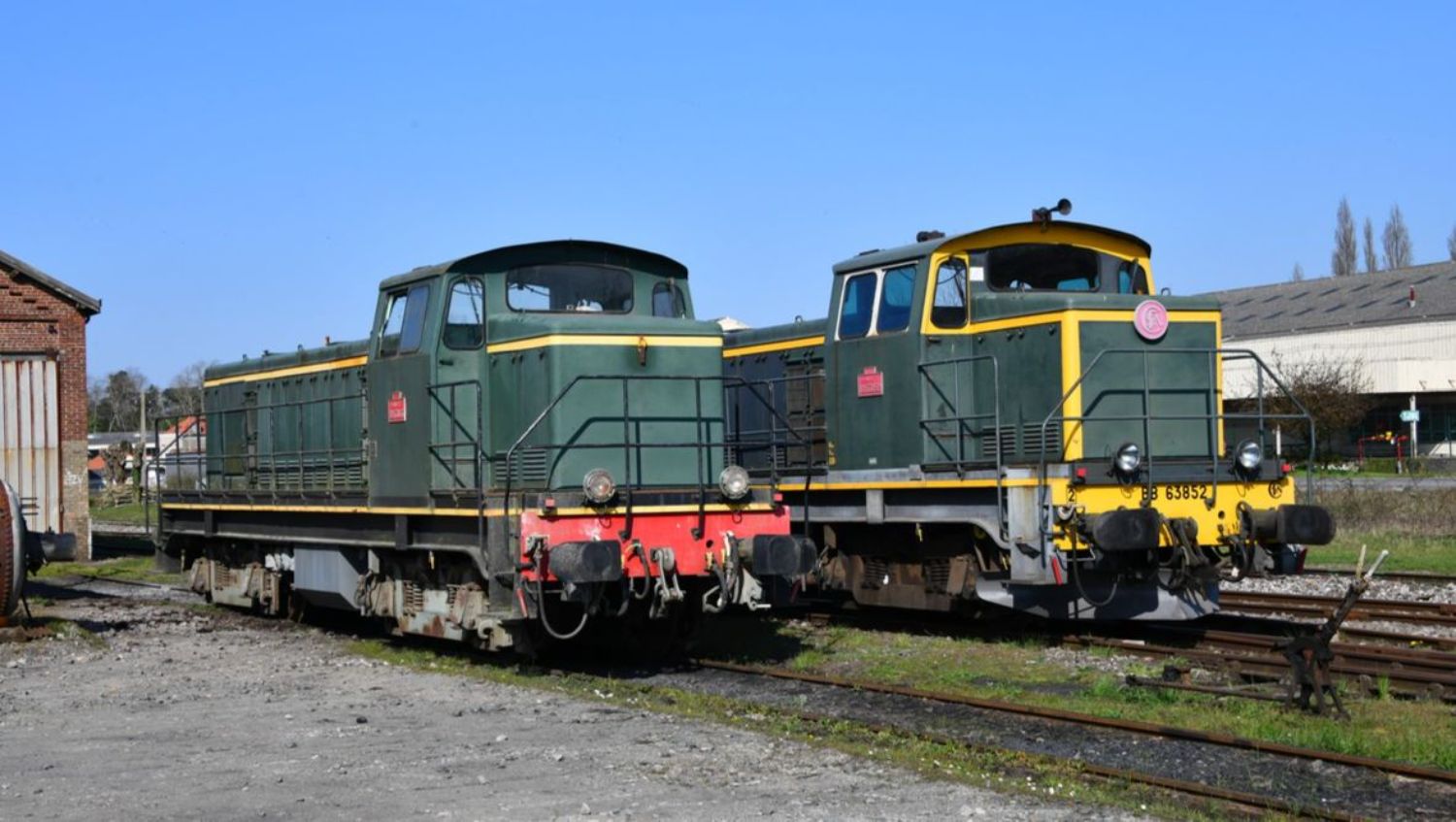
Following the engine failure of CFTVA's BB 63852, Chemin de Fer de Vendée has lent BB 63866 for the next five years. Both locomotives are seen at Arques on the 4 April. Photo: Didier Delattre.
Paimpol. The Vapeur du Trieux steam service between Paimpol and Pontrieux is running again this summer after a four-year break. Starting on 7 July, a single A/R runs Sundays to Thursdays until 31 August, tickets available at: lavapeurdutrieux@guingamp-paimpol.com
Train Rouge. The upgrading work mentioned in February News will now take place next spring, leaving the Rivesaltes – Caudiès-des-Fenouillèdes line in good order until 2028. Movement of calcium carbonate from Cases-de-Pène ceased at the end of 2024 and ownership of the branch looks likely to be transferred from SNCF to Train du Pays Cathare et du Fenouillèdes.
Val-de-Passey. Having sold its two locomotives last year, the 600mm gauge CF Val-de-Passey on a private estate in Meuthe-et-Moselle is being dismantled. Steam operation in this forest location is now considered too dangerous.
Gentiane Express. After winter 2023-24’s severe weather, 2,500 hours’ work was necessary to fit the line for last season, when 19,100 passengers were carried on the Bort-les-Orgues – Neussargues line. A consultant is to survey the infrastructure this year to determine maintenance priorities and assess future tourism potential. Financial assistance is being sought from the four communes through which the line passes.
Cotentin. Already under threat of closure due to financial pressures, Train Touristique du Cotentin suffered a fresh blow in March when 25 sleepers were stolen. Newly-laid at PN53, the timbers and the work involved cost €5,000.
Saint-Georges-de-Commiers. Vélorail des Alpes has started operations on the lower section of metre-gauge CF de la Mure, closed since a landslide in 2010. Electric vélorails are available for hire on the 7km between Saint-Georges and Notre-Dame-de-Commiers.
Vélorail du sud de l'Ardèche. Based at Saint-Jean-le-Centenier on the former line from Alès to Le Teil, has now closed permanently following the decision to convert the trackbed into a voie verte, a fate also suffered by the nearby metre-gauge line from Dunières to Raucoules-Brossette, and the Albret velorail at Moncrabeau in Lot-et-Garonne.
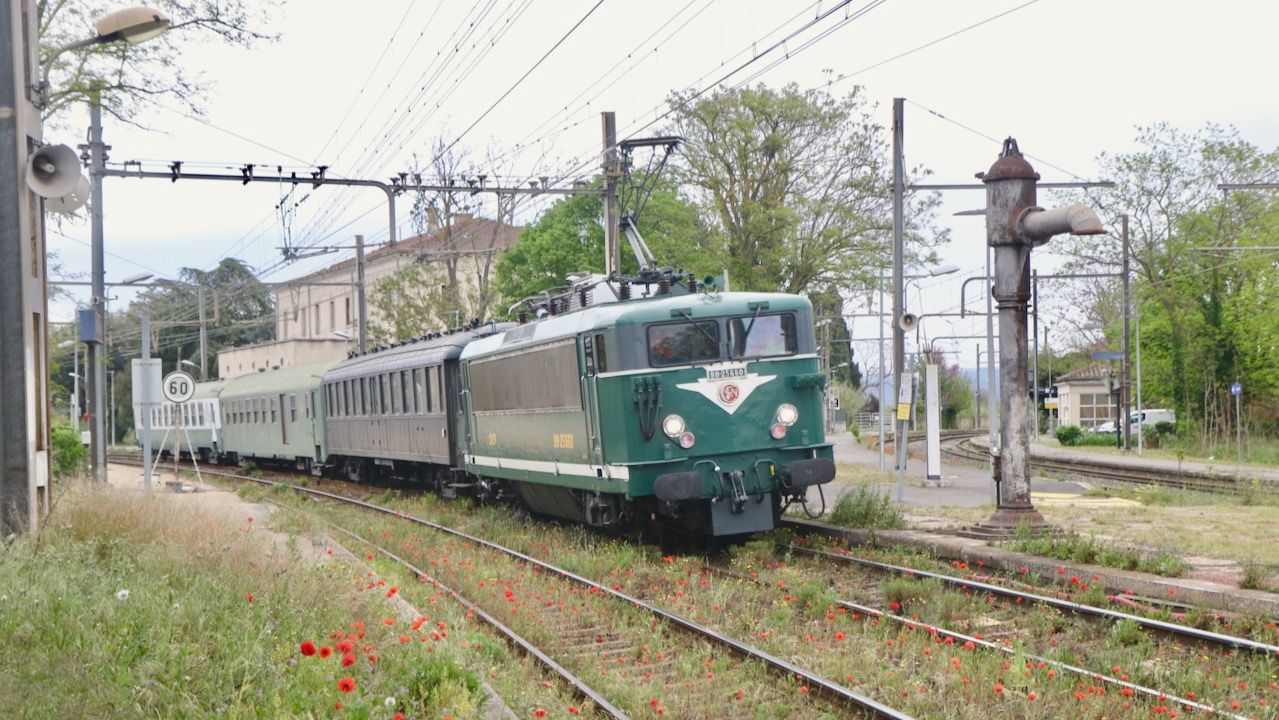
On Sunday 13 April APCC6570 ran a trip from Avignon to Narbonne and return with its less prestigious BB 25660 and three coaches borrowed from Train à Vapeur d’Auvergne. Seen above arriving through the poppies at Tarascon from Avignon with the Marseille tracks on the right. The water crane will have seen little use since the line was electrified in May 1960. The track to Avignon is currently limited to a speed of 60 km/h. Photo: Georges Turpin.
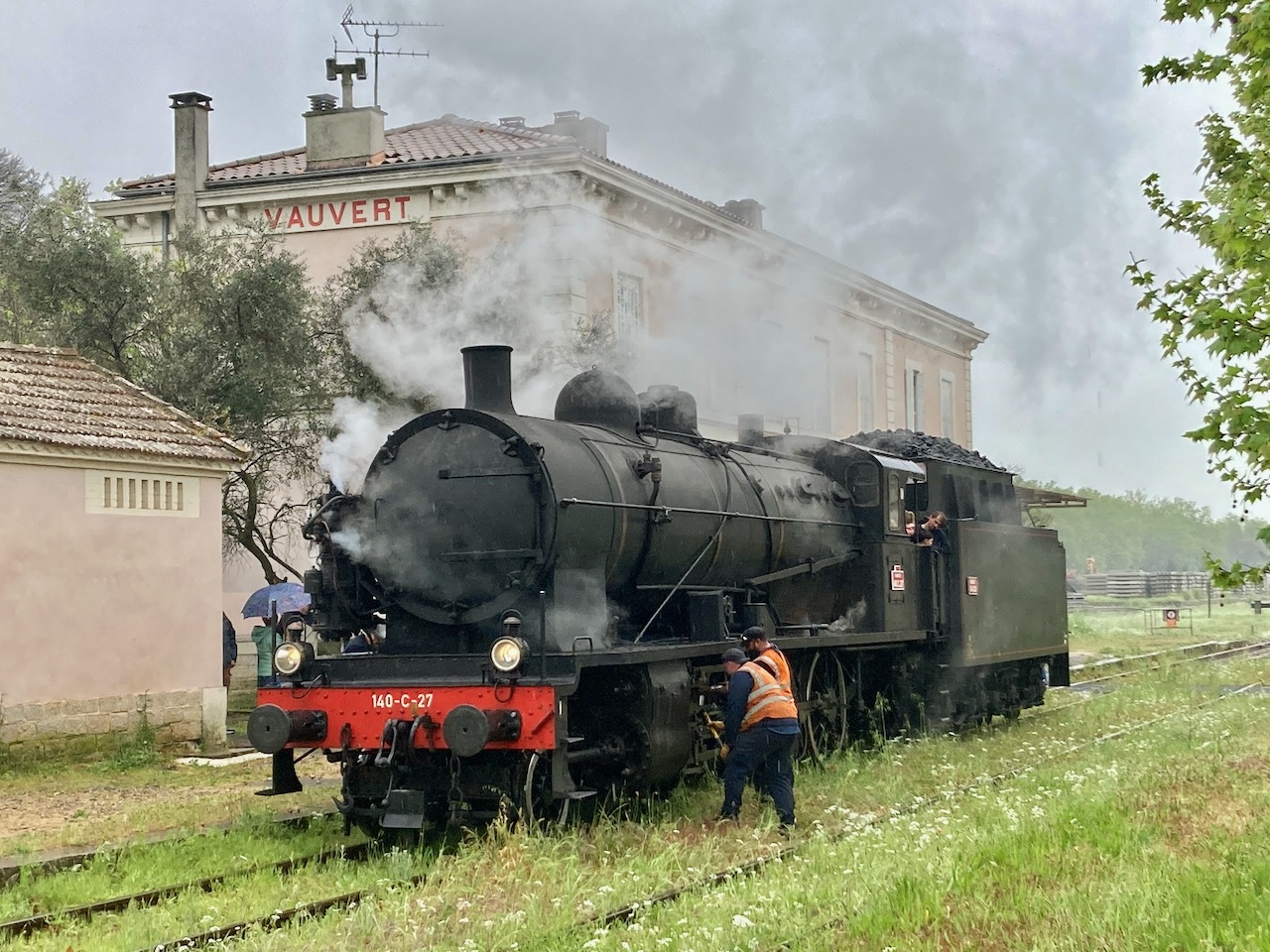
Over last winter the driving wheels of 140 C 27 have been to Meiningen for the tyres to be replaced. These have now been returned to Nîmes and refitted to the locomotive. On Sunday 13 April three running-in trips were made between Nîmes and Vauvert (Le Grau-du-Roi line) seen above after arrival at Vauvert with the crew carrying out an inspection. The loop here is currently out of use following discovery of instability in the formation during last winter’s upgrading work. A further €700,000 expenditure is required to remedy the situation and renew 600m of track. Regular use of the loop at Aigues-Mortes is not favoured because of the busy level crossing there, thus compromising the two-train summer service. SNCF hopes to reprogramme the work once finance can be agreed. Photo: Georges Turpin.
Urban News
Bordeaux metro corridor agreed
On 17 April Bordeaux Métropole agreed the third phase of planning for Line 1 of the metro, commissioning definitive assessment of the so-called Scénario Nord, a northeast – southwest zigzag across the city. Phase 2 studies by consultant Artelia set out five potential routes, of which version 3bis, the Nord corridor, was chosen as making the most significant contribution to relieving the tramway, with 157,000 daily journeys.
Line 1 would run from La Buttinière (Lormont) in the north along the alignment of overcrowded tram Line A, then through the Rive Droite and Arkéa Arena areas, crossing beneath the Garonne river to serve the Euratlantique development before heading north to Gare Saint-Jean, Mériadeck and Cité Administrative. The route then turns southwards to CHU Pellegrin (regional hospital), Talence-Médoquine and the university before looping north again to terminate at Pessac gare. The approximately 22.5km line would be largely in twin tunnels at some 20m depth, using automated technology. There would be 17 stations, with TER interchanges at Cenon (Brazza), Saint-Jean, Talence and Pessac, and with four tram and six express bus routes. Seven park-and-rides are planned. Cost is estimated at €2.25 billion including 30 trains.
The yellow dotted line is the Métropole’s preferred corridor, Scénario Nord. Map: Bordeaux Métropole.
Phase 3 will finalise the proposed route and station locations, evaluate the project’s socio-economic viability, refine park-and-ride options and assess changes to the planned express bus network to improve intermodal access. It will also look at locations for the line’s maintenance depot. The studies will complete the technical and strategic data on which the Métropole will base its decision next year on whether to go ahead with the project.
Trams will be disrupted in the city centre over the summer months whilst stabilisation work is carried out on the Pont de Pierre (Line A), as well as between Haillan Rostand and Mérignac Centre (A), and between Quinconces and Pyrénées (C and D) in preparation for creation of new routes E and F starting on 1 September.
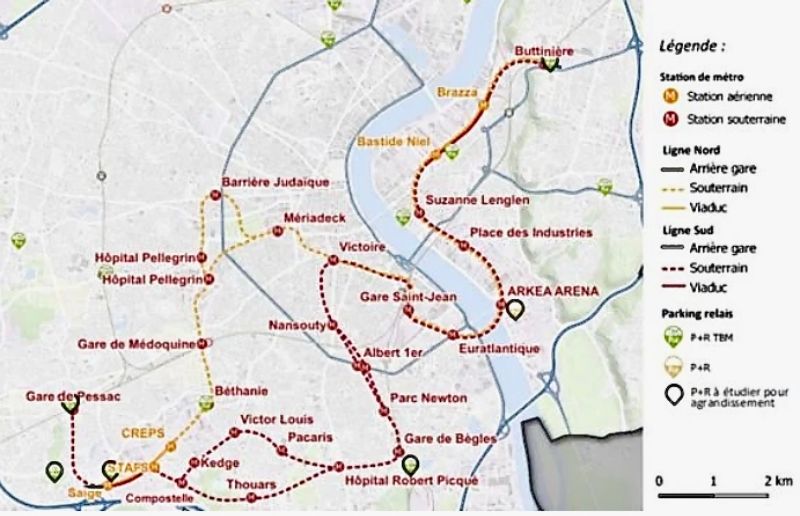
Paris M9. A new control room at Avenue de Versailles was commissioned at the end of January, part of the programme to equip the line with the Octys VB2 train control system. It replaces 1970s-era sites at Porte de Saint-Cloud and Porte de Montreuil. Work should be completed by 9 August.
Paris M14. With sufficient rolling stock on hand, the full service of trains every 85sec was inaugurated on 1 April. The last two of the fleet of 72 MP14 sets were due to be commissioned at the end of April.
Paris M14. With sufficient rolling stock on hand, the full service of trains every 85sec was inaugurated on 1 April. The last two of the fleet of 72 MP14 sets were due to be commissioned at the end of April.
Nantes. Test running started on 10 April over the 1.4km extension of Line 1 from Ranzay to Babinière, scheduled to open ion 23 May when its service will become the new Line 6. The section is distinguished by its crossing of the Erdre river on the pont de la Jonelière which also carries a cycleway and the Châteaubriant tram-train. At Babinière it will serve a multimodal interchange with bus and tram-train as well as park-and-ride, and provide access to the Cetex tram maintenance depot (opposite) opening in September; 61 long trams will be based here as well as Semitan administrative staff moving from the depot at Dalby where short trams are maintained. In a later stage, a further extension will link Babinière with Line 2 at Recteur Schmitt. Photo: Semitan.
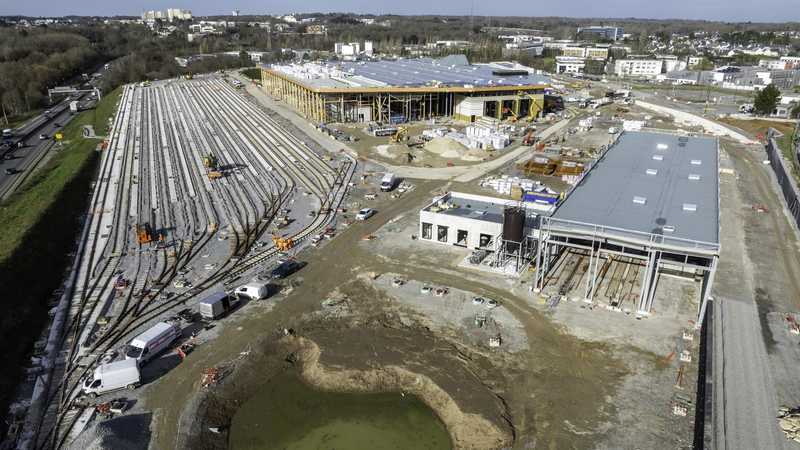
Rennes. Work started on 7 April at the J F Kennedy terminus of Line A to raise capacity by 25%. A second platform is to be built, located 50m north of the existing single-platform station due to its confined location beneath a shopping centre, and sidings provided to hold seven trains instead of the present four. Headway will be cut from 80 to 60 seconds and seven new trains ordered to enter service in late 2026.
Lyon. A visit last month to the T6 extension to La Doua in Villeurbanne found track laid on one-third of the 5.6km route and OLE being erected. Construction is on schedule for opening in a year’s time. Separately, the city’s labour inspectorate found several infringements of safety regulations at T10 worksites, affecting both construction workers and the public, including poor waste management of material containing asbestos. Sytral has reminded the construction companies of their responsibilities.
Photo:Sytral/J-PM.
Besançon. Delivery starts this month of five Citadis tramcars scheduled to enter service in September. A further three will follow next year, total cost €27 million.
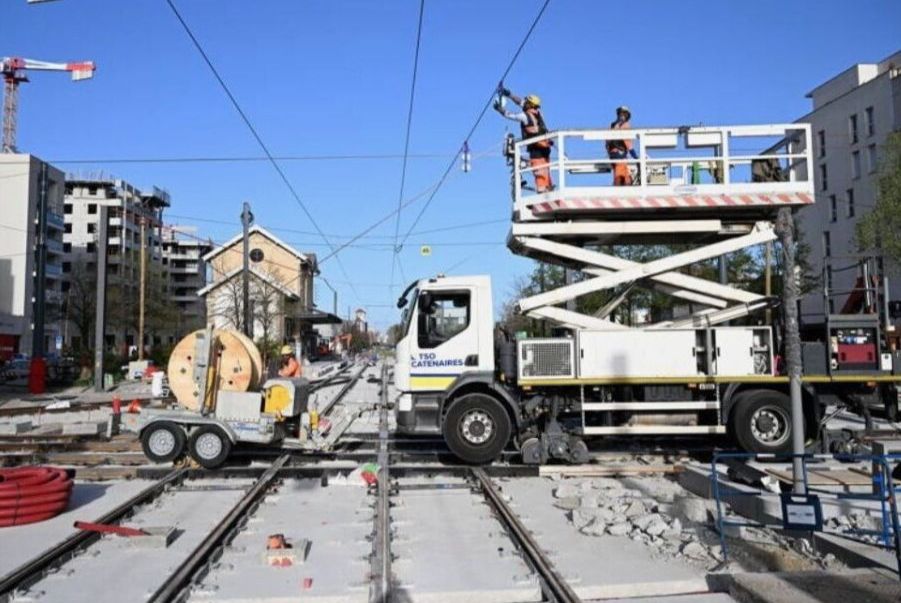
Additions to FRS Photographic Archive during March & April 2025
To Photographic section
- Jacques Poré’s photographs taken at the St Mandé model railway exhibition in January 2025 and that at Bourges in March 2025 to Folder 1 (Model Railway Exhibitions)
- All but 7 of the second series of Fiches Documentaires, published between 1993 and 2002 by Loco Revue, including an index (in 3 parts)
- Images of model railway exhibitions taken by our member Rod Welch to Folder 1 Model Railway Exhibitions under “FRS Models”
- FACS No. 421/Jan-Feb 2024 with the main article on the CFBS
- A small number of additional images to the David Thirlwall gallery following his visit to Normandy in March 2025
- A number of models in David Cuthbert’s collection have been added to Folder 1 (Model Railway Exhibitions & Members’ Models)
- A new Michael Bunn gallery in Folder 1, containing a variety of items from Michael’s collection
Additions to the FRS public folder during March & April 2025
- An index by subject for the first series of Loco-Revue Fiches Documentaires (Fiches nos 1/620)
- An updated photo index for the David Thirlwall gallery
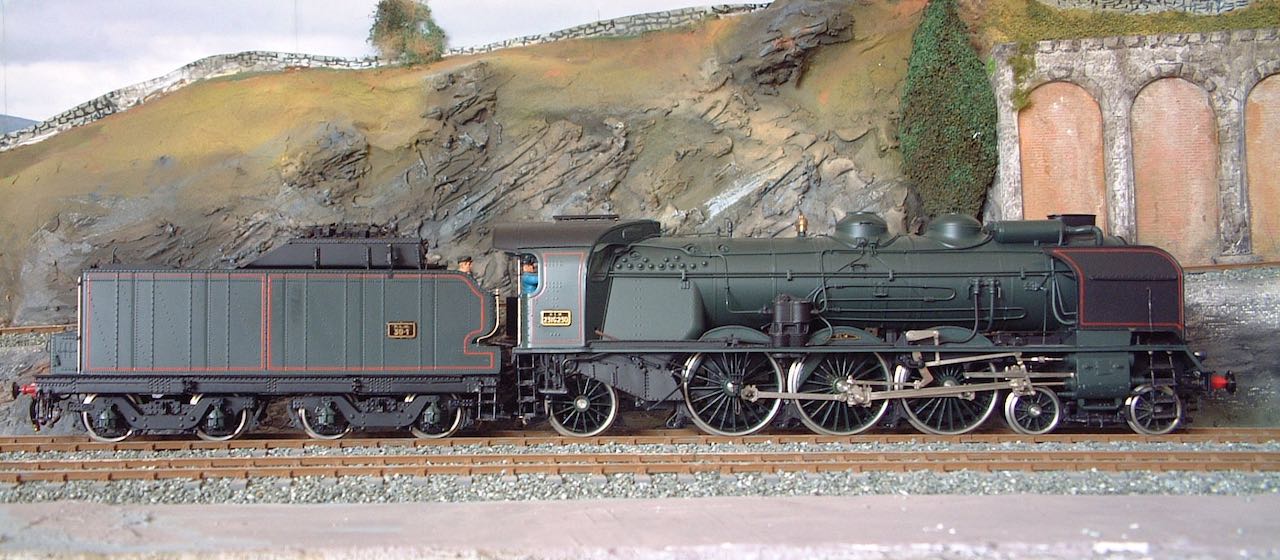
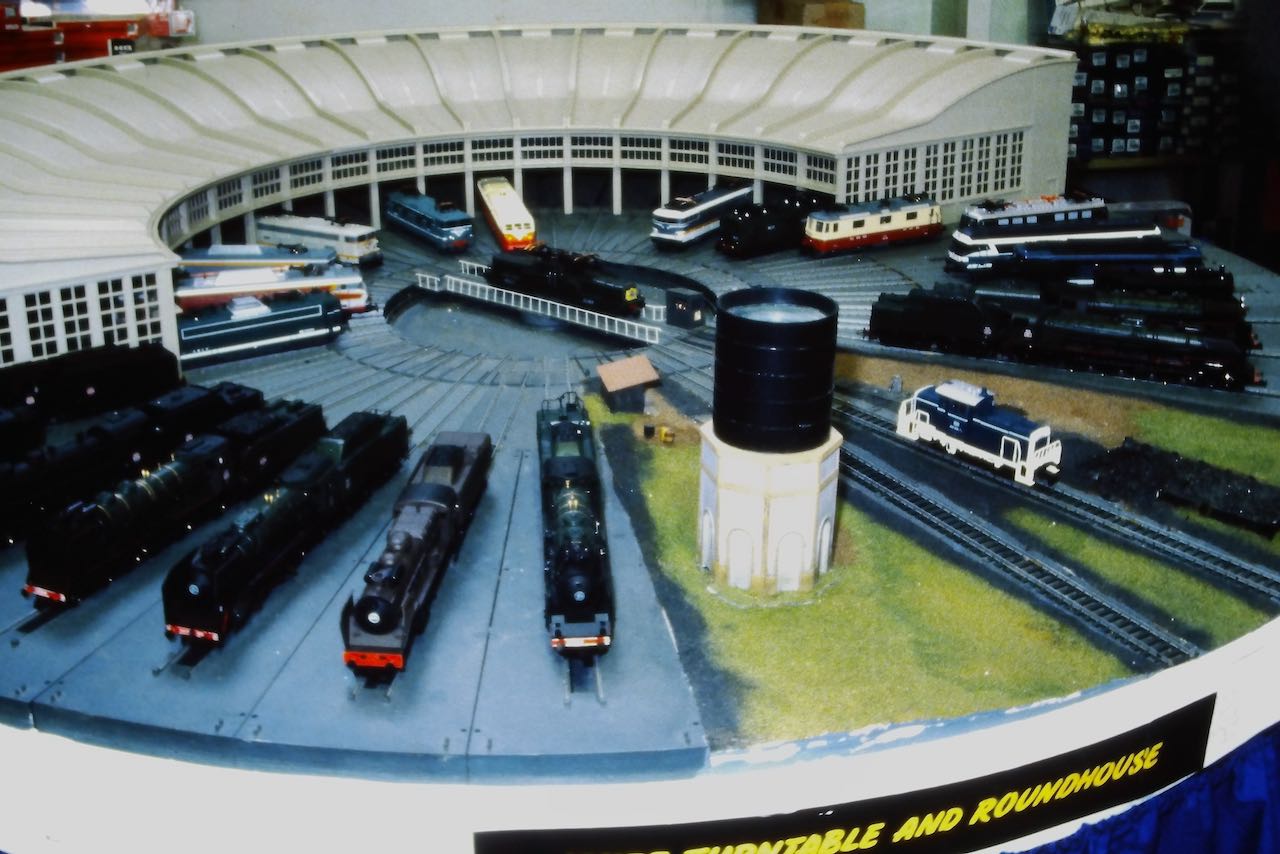

© Peter Lovell & Chris Bushell. The French Railways Society 2025. With thanks to Georges Turpin, Christophe Masse, Didier Delattre, Jean-Louis Poggi and Gordon Wiseman.
